PBE Europe as Axell Wireless 50-1876SERIES 50-1876SERIES Private Land Mobile Repeater User Manual RECEIVER MULTICOUPLER
Axell Wireless 50-1876SERIES Private Land Mobile Repeater RECEIVER MULTICOUPLER
Manual

Aerial Facilities Limited
Two Channel UHF Repeater
For
Inner Wireless Inc.
AFL Works Order: Q115559
AFL product part #: 50-187601
Aerial Facilities Limited
Technical Literature
2 Channel UHF Cell Enhancer Handbook
Handbook Number: 50-187601HBKM Issue No. A Date 22/05/2007 Page 1 of 51
Two Channel UHF Cell Enhancer
User Handbook
Handbook Number: 50-187601HBKM Page: 2 of 51
Table of Contents
1. INTRODUCTION ............................................................................................................4
Scope and Purpose of Document....................................................................................................4
Limitation of Liability Notice............................................................................................................4
2. SAFETY CONSIDERATIONS ........................................................................................5
2.1 Earthing of Equipment......................................................................................................... 5
2.2 Electric Shock Hazard..........................................................................................................5
2.3 RF Radiation Hazard ............................................................................................................5
2.4 Chemical Hazard ..................................................................................................................6
2.5 Laser Safety..........................................................................................................................6
2.6 Emergency Contact Numbers.............................................................................................6
3. EQUIPMENT OVERVIEW ..............................................................................................7
3.P Photographs .........................................................................................................................7
3.1 Description..........................................................................................................................10
3.2 Technical Specification .....................................................................................................10
3.3 Mechanical Specification...................................................................................................11
3.4 Parts List.............................................................................................................................12
3.5 System Diagram .................................................................................................................13
4. SUB-UNIT MODULES..................................................................................................14
4.1 Bandpass Filter (02-010201).............................................................................................. 14
4.1.1 Description .......................................................................................................................................14
4.1.2 Technical Specification ....................................................................................................................14
4.2 Two-Way Splitter (07-002503)............................................................................................15
4.2.1 Description .......................................................................................................................................15
4.2.2 Technical Specification ....................................................................................................................15
4.2.3 Drg. # 07-002501, 2 Way Splitter Assembly Drawing .....................................................................16
4.3 0.25Watt 0- -30dB Switched Attenuator (10-000703).......................................................17
4.3.1 General Application..........................................................................................................................17
4.3.2 Switched Attenuators .......................................................................................................................17
4.3.3 Switched Attenuator Assembly Drawing, Drg. # 10-000703 ...........................................................18
4.3.4 0-30dB Attenuator Circuit Diagram, Drg. # 10-000770 ...................................................................19
4.4 11-007302 & 11-007402 Low Noise Amplifiers.................................................................20
4.4.1 Description .......................................................................................................................................20
4.4.2 Technical Specification (11-007302) ...............................................................................................20
4.4.3 Technical Specification (11-007402) ...............................................................................................20
4.4.4 LNA ‘D’ Connector Pin-out details ...................................................................................................21
4.4.5 Drg. # 11-007302, LNA Assembly With Alarm Relay ......................................................................22
4.4.6 Drg. # 11-007370, LNA RF Circuit Diagram ....................................................................................23
4.4.7 Drg. # 11-007371, LNA DC Wiring Diagram....................................................................................24
4.4.8 Drg. # 11-003971, LNA DC Circuit Diagram....................................................................................25
4.4.9 Drg. # 11-007402, LNA Assembly With Alarm Relay ......................................................................26
4.4.10 Drg. # 11-007470, LNA RF Circuit Diagram ....................................................................................27
4.5 12-021601 5Watt Medium Power Tetra Amplifier.............................................................28
4.5.1 Description .......................................................................................................................................28
4.5.2 Technical Specification ....................................................................................................................28
4.5.3 PA 7-Way Connector Pin-outs.........................................................................................................28
4.5.4 PA Connector Pin-Outs ...................................................................................................................28
4.5.5 5W TETRA PA Assembly Drawing, Drg. # 12-021601....................................................................29
4.5.6 5W TETRA PA Circuit Diagram, Drg. # 12-021670.........................................................................30
4.6 12-022101 10Watt Power Tetra Amplifier ......................................................................... 31
4.6.1 Description .......................................................................................................................................31
4.6.2 Technical Specification ....................................................................................................................31
4.6.3 PA 7-Way Connector Pin-Outs ........................................................................................................32
4.6.4 PA Connector Pictorial Pin-Outs......................................................................................................32
4.6.5 10Watt PA Assembly Drawing, Drg. # 12-022101...........................................................................33
4.6.6 10Watt PA Circuit Diagram, Drg. # 12-022171................................................................................34
Two Channel UHF Cell Enhancer
User Handbook
Handbook Number: 50-187601HBKM Page: 3 of 51
4.7 8A Mains Filter Assembly (13-003301) ............................................................................. 35
4.7.1 Description .......................................................................................................................................35
4.7.2 Technical Specification ....................................................................................................................35
4.8 Channel Control Module (17-002101) ...............................................................................36
4.8.1 Description .......................................................................................................................................36
4.8.2 Technical Specification ....................................................................................................................36
4.8.3 VHF/ UHF Programming Procedure ................................................................................................36
4.8.4 VHF/ UHF Programming Example...................................................................................................37
4.9 Channel Selective Module (17-003007) ............................................................................38
4.9.1 Description .......................................................................................................................................38
4.9.2 Generic Channel Module Block Diagram, Drg. # 17-003080 ..........................................................39
4.10 12V Single Relay Board (80-008901)................................................................................. 40
4.10.1 Description .......................................................................................................................................40
4.10.2 Technical Specification ....................................................................................................................40
4.10.3 12 or 24V Relay PCB Pin-Outs, Drg. # 80-008970 .........................................................................41
4.11 12V Switch-Mode PSU (96-300052)...................................................................................42
4.11.1 Description .......................................................................................................................................42
4.11.2 Technical Specification ....................................................................................................................42
5. INSTALLATION............................................................................................................43
5.1 Initial Installation Record...................................................................................................43
6. FAULT FINDING & MAINTENANCE ...........................................................................43
6.1 General Fault Finding Procedures.................................................................................... 43
6.2 Downlink .............................................................................................................................44
6.3 Uplink ..................................................................................................................................44
6.4 Fault repair..........................................................................................................................44
6.5 Checking service................................................................................................................45
6.6 Service Support..................................................................................................................45
6.7 Tools & Test Equipment ....................................................................................................45
6.8 General Maintenance Procedures .................................................................................... 46
6.9 Module Removal (LNA’s, general procedure)..................................................................46
6.10 Module Replacement (general) ......................................................................................... 46
6.11 Power Amplifiers................................................................................................................46
6.12 Low Power Amplifier Replacement .................................................................................. 47
6.13 Module Transportation ......................................................................................................47
APPENDIX A.........................................................................................................................48
Amendment List Record Sheet......................................................................................................48
Glossary of Terms...........................................................................................................................49
Key to AFL Drawing Symbols ........................................................................................................50
APPENDIX B.........................................................................................................................51
Initial Equipment Set-Up Calculations ..........................................................................................51
General Information.........................................................................................................................................51
Antenna Systems ............................................................................................................................................51
Initial Parameters.............................................................................................................................................51
Downlink Calculations .....................................................................................................................................51
Uplink Calculations ..........................................................................................................................................51
Two Channel UHF Cell Enhancer
User Handbook
Handbook Number: 50-187601HBKM Page: 4 of 51
1. INTRODUCTION
Scope and Purpose of Document
This handbook is for use solely with the equipment identified by the AFL Part Number shown on the
front cover. It is not to be used with any other equipment unless specifically authorised by Aerial
Facilities Limited. This is a controlled release document and, as such, becomes a part of Aerial
Facilities’ Total Quality Management System. Alterations and modification may therefore only be
performed by Aerial Facilities Ltd.
AFL recommends that the installer of this equipment familiarise his/herself with the safety and
installation procedures contained within this document before installation commences.
The purpose of this handbook is to provide the user/maintainer with sufficient information to service
and repair the equipment to the level agreed. Maintenance and adjustments to any deeper level must
be performed by AFL, normally at the company’s repair facility in Chesham, England.
This handbook has been prepared in accordance with BS 4884, and AFL’s Quality procedures, which
maintain the company’s registration to BS EN ISO 9001:2000 and to the R&TTE Directive of the
European Parliament. Copies of the relevant certificates and the company Quality Manual can be
supplied on application to the Quality Manager.
This document fulfils the relevant requirements of Article 6 of the R&TTE Directive.
Limitation of Liability Notice
This manual is written for the use of technically competent operators/service persons. No liability is
accepted by AFL for use or misuse of this manual, the information contained herein, or the
consequences of any actions resulting from the use of the said information, including, but not limited
to, descriptive, procedural, typographical, arithmetical, or listing errors.
Furthermore, AFL does not warrant the absolute accuracy of the information contained within this
manual, or it’s completeness, fitness for purpose, or scope.
AFL has a policy of continuous product development and enhancement, and as such, reserves the
right to amend, alter, update and generally change the contents, appearance and pertinence of this
document without notice.
All AFL products carry a twelve month warranty from date of shipment. The warranty is expressly on a
return to base repair or exchange basis and the warranty cover does not extend to on-site repair or
complete unit exchange.

2. SAFETY CONSIDERATIONS
2.1 Earthing of Equipment
Cell Enhancers supplied from the mains must be connected to grounded outlets and
earthed in conformity with appropriate local, national and international electricity
supply and safety regulations.
2.2 Electric Shock Hazard
Electrical shocks due to faulty mains driven power supplies.
Whilst ever potentially present in any electrical equipment, such a condition would be
minimised by quality installation practice and thorough testing at:
a) Original assembly
b) Commissioning
c) Regular intervals, thereafter.
All test equipment to be in good working order prior to its use. High current power supplies can be
dangerous because of the possibility of substantial arcing. Always switch off during disconnection and
reconnection.
2.3 RF Radiation Hazard
Two Channel UHF Cell Enhancer
User Handbook
Handbook Number: 50-187601HBKM Page: 5 of 51
RF radiation, (especially at UHF frequencies) arising from transmitter outputs
connected to AFL’s equipment, must be considered a safety hazard.
This condition might only occur in the event of cable disconnection, or because a
‘spare’ output has been left unterminated. Either of these conditions would impair the
system’s efficiency. No investigation should be carried out until all RF power sources have been
removed. This would always be a wise precaution, despite the severe mismatch between the
impedance of an N type connector at 50Ω, and that of free space at 377Ω, which would severely
mitigate against the efficient radiation of RF power. Radio frequency burns could also be a hazard, if
any RF power carrying components were to be carelessly touched!
Antenna positions should be chosen to comply with requirements (both local & statutory) regarding
exposure of personnel to RF radiation. When connected to an antenna, the unit is capable of
producing RF field strengths, which may exceed guideline safe values especially if used with
antennas having appreciable gain. In this regard the use of directional antennas with backscreens
and a strict site rule that personnel must remain behind the screen while the RF power is on, is
strongly recommended.
Where the equipment is used near power lines, or in association with temporary masts not having
lightning protection, the use of a safety earth connected to the case-earthing bolt is strongly advised.

2.4 Chemical Hazard
Beryllium Oxide, also known as Beryllium Monoxide, or Thermalox™, is sometimes
used in devices within equipment produced by Aerial Facilities Ltd. Beryllium oxide
dust can be toxic if inhaled, leading to chronic respiratory problems. It is harmless if
ingested or by contact.
Products that contain beryllium are load terminations (dummy loads) and some power amplifiers.
These products can be identified by a yellow and black “skull and crossbones” danger symbol (shown
above). They are marked as hazardous in line with international regulations, but pose no threat under
normal circumstances. Only if a component containing beryllium oxide has suffered catastrophic
failure, or exploded, will there be any danger of the formation of dust. Any dust that has been created
will be contained within the equipment module as long as the module remains sealed. For this reason,
any module carrying the yellow and black danger sign should not be opened. If the equipment is
suspected of failure, or is at the end of its life-cycle, it must be returned to Aerial Facilities Ltd for
disposal.
To return such equipment, please contact the Quality Department, who will give you a Returned
Materials Authorisation (RMA) number. Please quote this number on the packing documents, and on
all correspondence relating to the shipment.
PolyTetraFluoroEthylene, (P.T.F.E.) and P.T.F.E. Composite Materials
Many modules/components in AFL equipment contain P.T.F.E. as part of the RF insulation barrier.
This material should never be heated to the point where smoke or fumes are evolved. Any person
feeling drowsy after coming into contact with P.T.F.E. especially dust or fumes should seek medical
attention.
2.5 Laser Safety
General working practices adapted from EN60825-2: 2000
“Do not stare with unprotected eyes or with any unapproved optical device at the fibre
ends or connector faces or point them at other people.”
“Use only approved filtered or attenuating viewing aids.”
“Any single or multiple fibre end or ends found not to be terminated (for example,
matched, spliced) shall be individually or collectively covered when not being worked
on. They shall not be readily visible and sharp ends shall not be exposed.”
“When using test cords, the optical power source shall be the last connected and the first
disconnected.”
“Use only approved methods for cleaning and preparing optical fibres and optical connectors.”
Always keep optical connectors covered to avoid physical damage
Do not allow any dirt/foreign material ingress on the optical connector bulkheads.
The optical fibre jumper cable maximum bend radius is 3cm, any smaller radii may result in optical
cable breakage or excessive transmission losses.
Caution: The FO units are NOT weather proof.
2.6 Emergency Contact Numbers
The AFL Quality Department can be contacted on:
Telephone +44 (0)1494 777000
Fax +44 (0)1494 777002
e-mail qa@aerialfacilities.com
Two Channel UHF Cell Enhancer
User Handbook
Handbook Number: 50-187601HBKM Page: 6 of 51
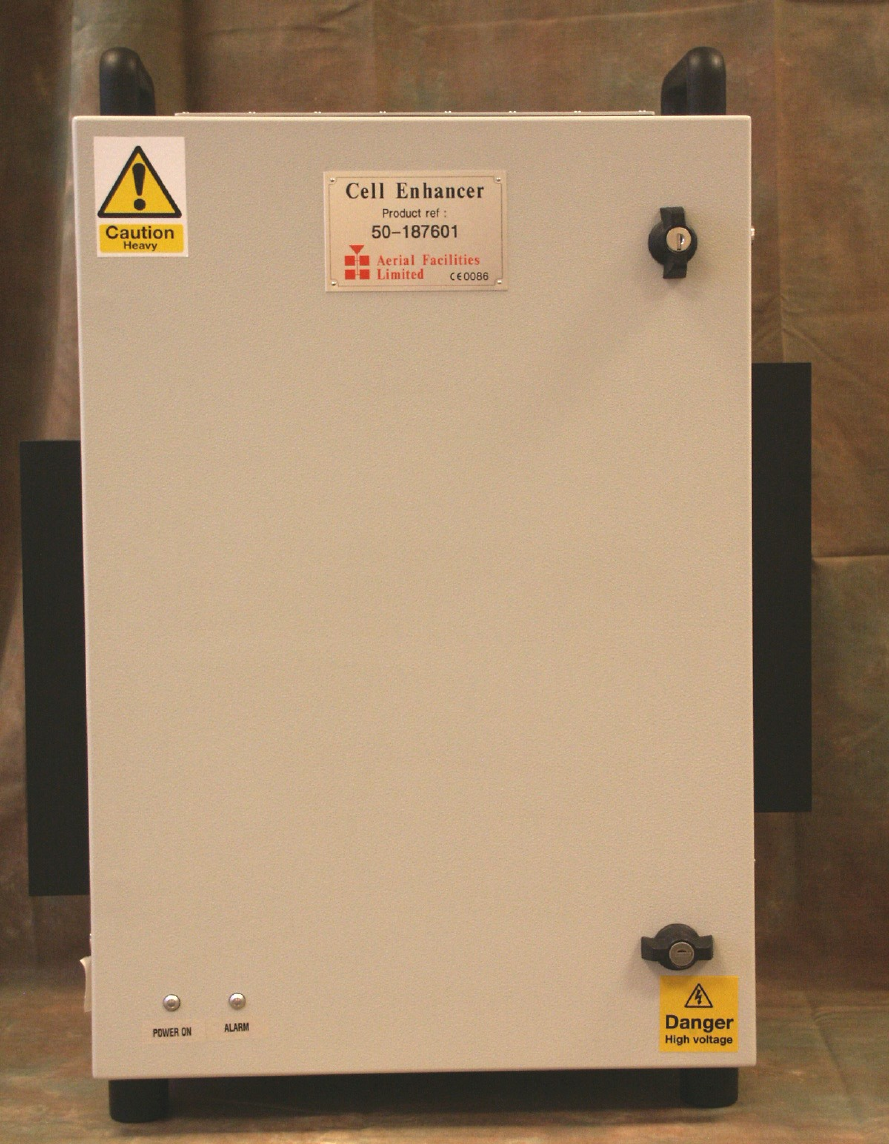
3. EQUIPMENT OVERVIEW
3.P Photographs
External front view, door closed
Two Channel UHF Cell Enhancer
User Handbook
Handbook Number: 50-187601HBKM Page: 7 of 51
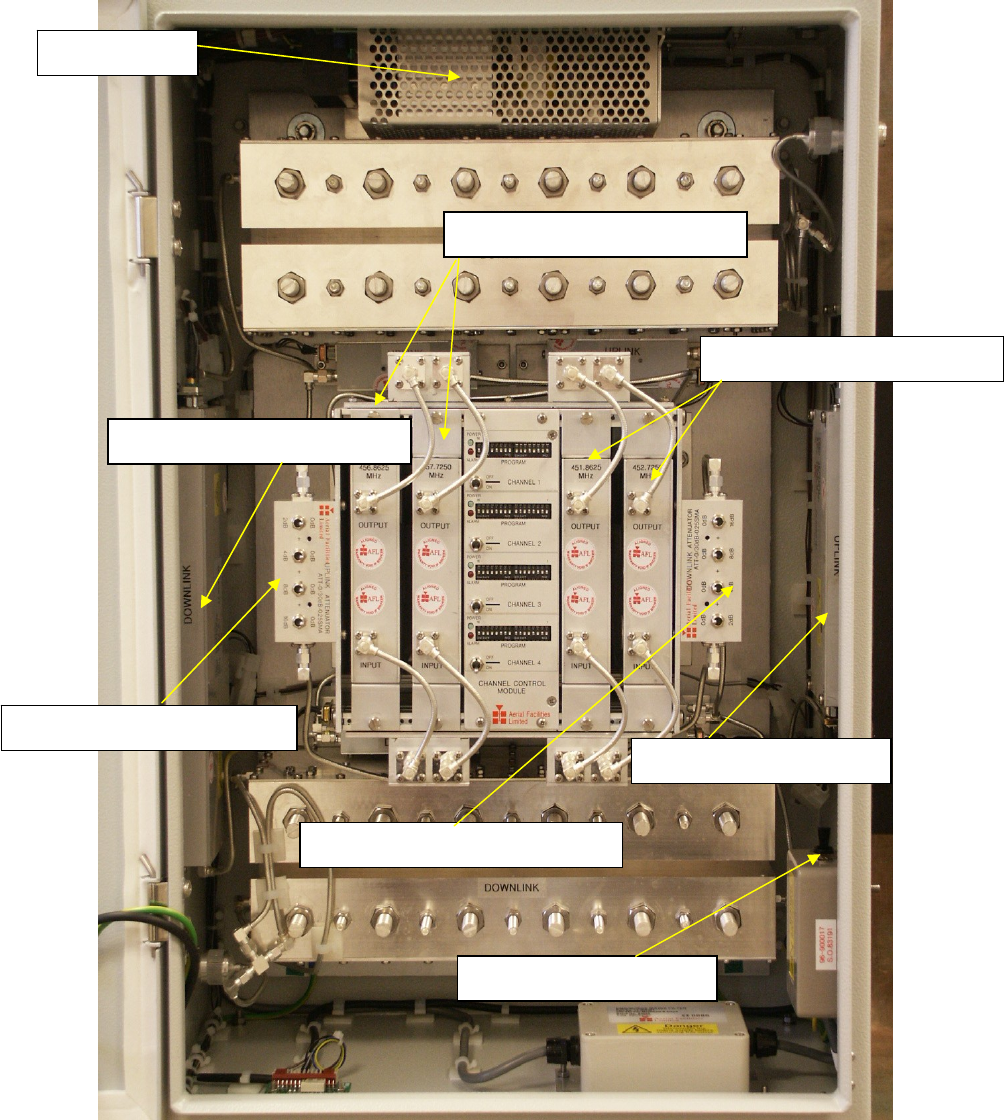
Photographs continued...............
Mains PSU
Uplink channel modules
Two Channel UHF Cell Enhancer
User Handbook
Handbook Number: 50-187601HBKM Page: 8 of 51
Internal view, door open
Downlink channel modules
Downlink power amplifier
Uplink switched attenuator
Uplink power amplifier
Downlink switched attenuator
Mains isolation switch

Photographs continued...............
View of R.H.S Ports & Earthing bolt
View of L.H.S (Base) Ports
Two Channel UHF Cell Enhancer
User Handbook
Handbook Number: 50-187601HBKM Page: 9 of 51
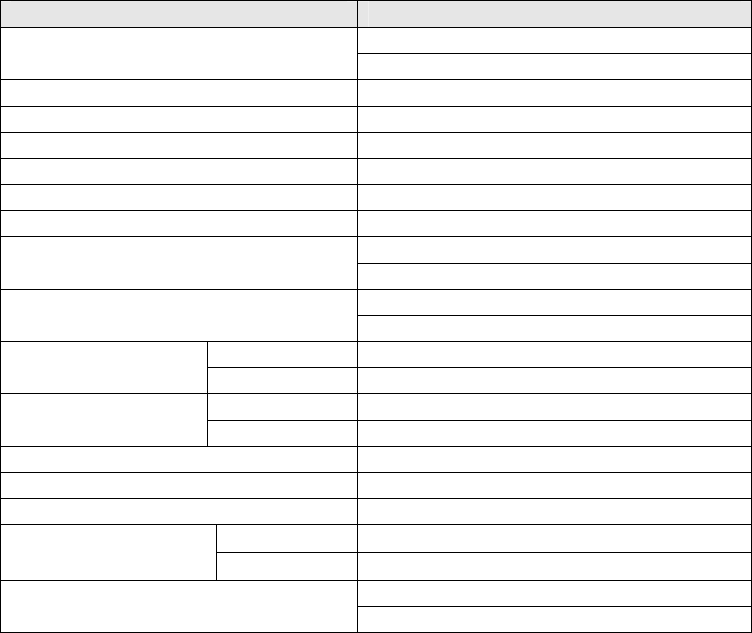
Two Channel UHF Cell Enhancer
User Handbook
Handbook Number: 50-187601HBKM Page: 10 of 51
3.1 Description
The cell enhancer is constructed within an environmentally protected case which may be either free-
standing or (usually) permanently secured to a vertical wall.
The unit is an on-frequency, two-way repeater which draws its downlink input from an off-air antenna,
amplifies the signal through a pair of channel selective modules, (the modules ‘pick-out’ the channel
from within the frequency band, subjecting it to automatic gain, phase-locked tuning using a set of 16
DIP switches to digitally control the channel frequency). Downlink output to the mobile antenna is
approximately 10Watts and the uplink output to the base antenna is approximately 5Watts.
The whole system is powered from a mains-driven PSU module which supplies 12V DC from 115V
AC mains at a power not exceeding 150Watts. No battery backup is fitted to this system.
All active devices have in-built alarm circuitry which terminates as volt-free, relay contact pairs on an
internal connector. These pairs may be wired in series to produce a single pair that is the ‘sum’ of all
the alarmed devices in the system.
3.2 Technical Specification
PARAMETER SPECIFICATION
451.5-453.0MHz (Downlink)
Frequency range: 456.5-458.0MHz (Uplink)
Bandwidth: 1.5MHz
Passband ripple: ±1.5dB
Gain: >90dB (typical)
Gain Adjustment: 0 - 30dB (in 2dB steps)
Uplink Power: >5Watts
Downlink Power: >10Watts
54dBm (downlink)
Third order intercept point(OIP3): 50dBm (uplink)
40.3dBm (downlink)
1dB compression point: 37.5dBm (uplink)
Downlink: -21dBm
AGC: Uplink: -20dBm
Downlink: 10dB (downlink)
Chan module gain: Uplink: 15dB (uplink)
Noise Figure: <6dB
VSWR: better than 1.5:1
RF Connectors: N type, female
operational: -10°C to +60°C
Temperature range:
storage: -40°C to +70°C
1 Amplifiers Alarms Fitted:
(volt-free contacts/TTL) 2 PSU
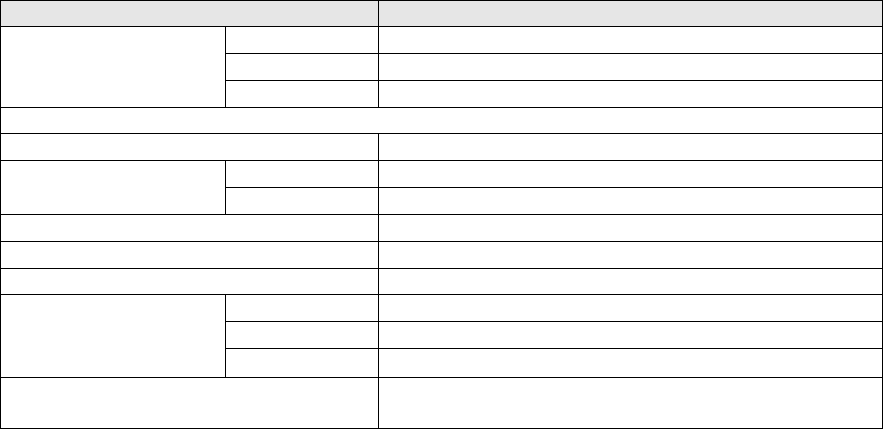
Two Channel UHF Cell Enhancer
User Handbook
Handbook Number: 50-187601HBKM Page: 11 of 51
3.3 Mechanical Specification
PARAMETER SPECIFICATION
Height: 620mm
Width: 420mm
Case size
Depth: 250mm
(excluding heatsinks, connectors, handles and feet)
Fixings: 4 holes on 470(w) x 500(h)mm
operational: -10°C to +60°C
Temperature
Range: storage: -40°C to +70°C
Weight: 25kg (approximately)
RF Connectors: N type female
Environmental Protection: IP65 (with door closed and all ports terminated)
Case: To RAL 7032/5
Heatsinks: Matt black (where fitted)
Finish:
Handles: Black Technopolymer
Supply Cable: Unit supplied with suitable supply input leads with
connector and appropriate length of cable
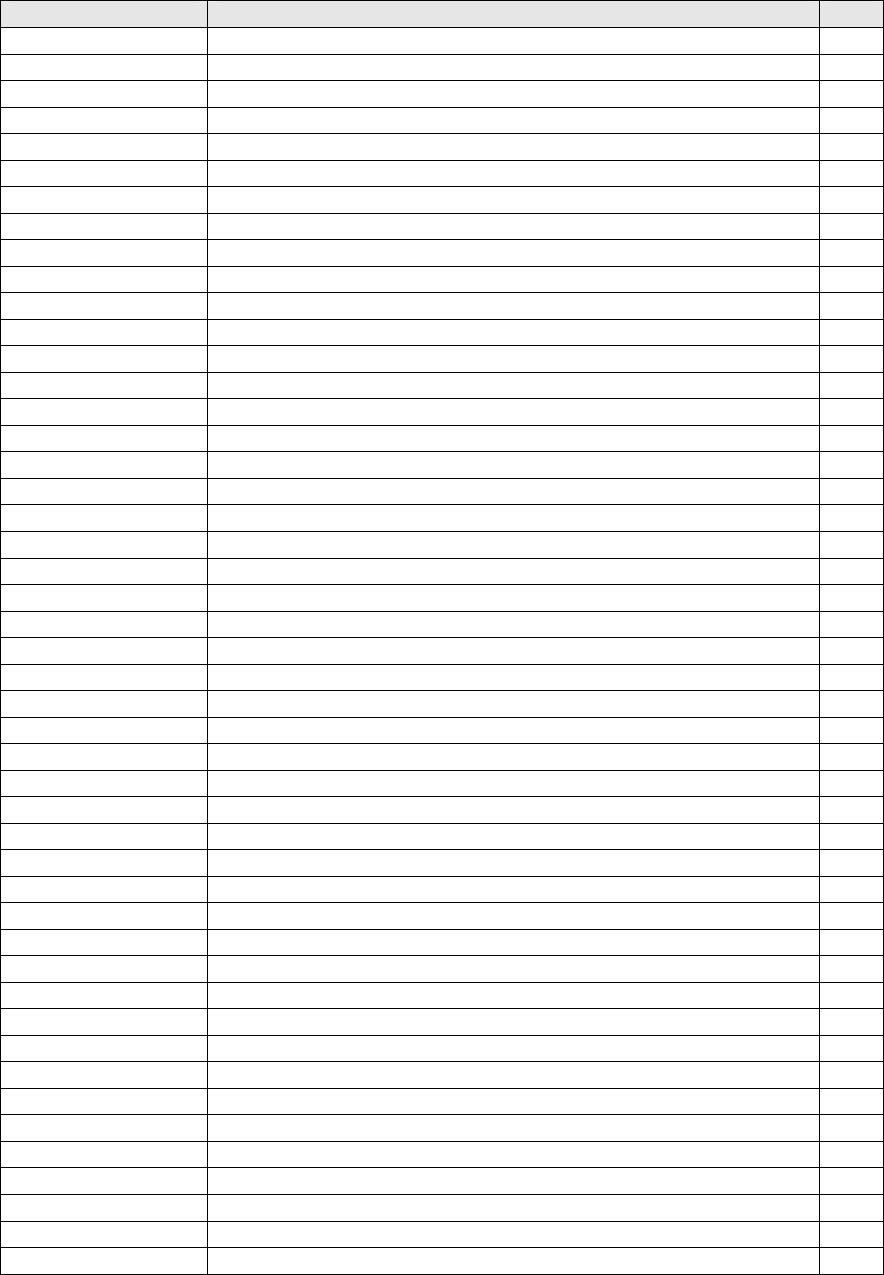
Two Channel UHF Cell Enhancer
User Handbook
Handbook Number: 50-187601HBKM Page: 12 of 51
3.4 Parts List
AFL Part # Part Description Qty.
02-010201 6P C/L FILTER 380-500 <4 MHz SMA 4
07-002503 2 WAY SPLITTER 50/500MHz SMA 4
10-000703 1/4W 0-30dB SWITCHED ATTENUATOR 2
11-007302 LNA. 380-500MHz 20dB (C/W RELAY) GA 2
11-007402 LNA. 380-500MHz 30dB (C/W RELAY) GA 2
12-021601 TETRA 5W +12V AMPLIFIER 1
12-022101 PA 380-470MHz 10W CLASS A +12V 1
13-003301 MAINS FILTER 8AMP ASSEMBLY 1
17-000126 CELL ENHANCER LABEL 6 DIGIT 1
17-000526 CE 10W HEATSINK THERMAL GASKET 3
17-001522 BASE PLATE 560 x 345mm 17-001520&9020 1
17-001523 GREY RAL7032 H/SINK BLANKING PLATE 1
17-002101 CHANNEL CONTROL MODULE 1
17-002103 26WAY RIBBON CABLE LEAD 4
17-003007 CHAN MOD 450MHz, 30kHz B/W 8 pole 4
17-003022 MODULE PATTERNED LEAVE 4
17-003023 SUBRACK SIDE PANEL 2
17-003024 SUBRACK REAR BRACKET 2
17-003025 BOTTOM MODULE GUIDE 4
17-003029 TOP MODULE GUIDE 4
17-009020 ENCLOSURE 620 x 420 x 250 (3 H/S) ALU 1
80-008901 12V RELAY PCB ASSEMBLY **NO LED** 1
80-032320 10W PA HEATSINK 2
90-100009 CABLE 3CORE MAINS '6 A' USA COLOURS 1
90-400006 6 pin BULGIN ALARM LEAD 1
91-030002 N ADAPTOR PANEL FEMALE:FEMALE 2
91-130001 SMA ADAPT 'T' ALL FEMALE 3 GHz 2
91-500011 PWR 3POLE PNL PLUG SEALED IP68 1
91-500015 PWR CON CAP SEALED with INT. THREAD 2
91-500016 PWR 6POLE PNL PLUG SEALED IP68 1
91-600005 'D' 9 WAY SOCKET S/B TERM 4
91-600007 'D' 9 WAY BLACK SHELL 4
91-600019 'D'15 WAY SHELL (2W7) 2
91-640004 LARGE PIN FOR 91-660001 D SOCKET 4
91-660001 2W5 MIXED D TYPE SOCKET (7 WAY) 2
91-700017 ICD 15 WAY 0.1' CONNECTOR 1
92-280033 Captive Screw 8
96-300052 JWS150-12/A PSU (COUTANT LAMBDA) 1
96-700034 LED RED 5mm IP67 INTEGRAL RES. 24V 1
96-700035 LED GREEN 5mm IP67 INTEGRAL RES 24V 1
96-900017 AC TRIP SWITCH (3 AMP M.C.B.) 1
97-000002 BLACK MODULE CAGE RUNNER 8
97-300010 C/E SUPPLY INPUT COVER 1
97-400011 BLACK POLYMIDE HANDLE 120mm 2
97-400012 SCHROFF BLACK DOOR LOCK 20234 024 2
97-600002 SUBRACK M2.5 STD TAP 2
97-900004 RUBBER FOOT FOR CELL ENHANCERS 4
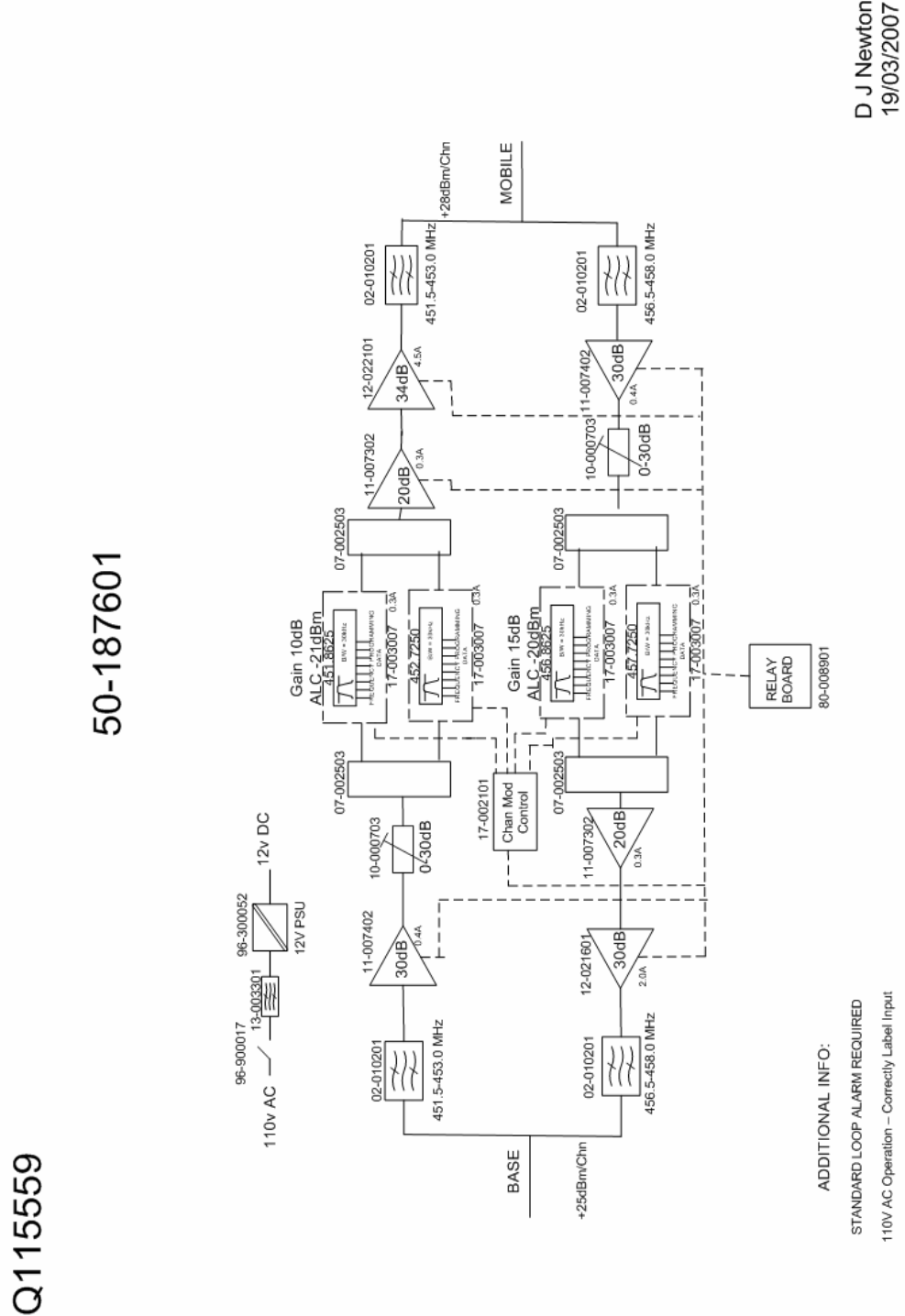
3.5 System Diagram
Two Channel UHF Cell Enhancer
User Handbook
Handbook Number: 50-187601HBKM Page: 13 of 51
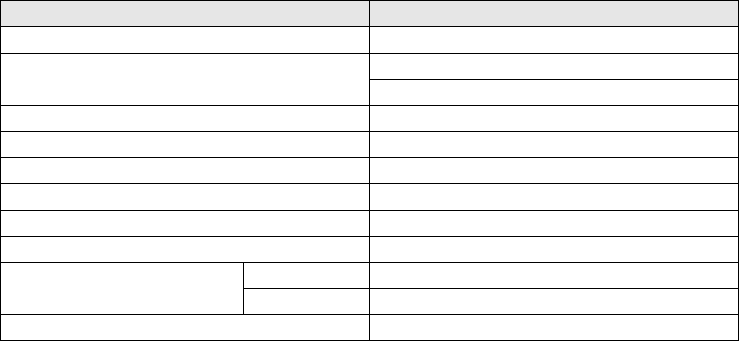
Two Channel UHF Cell Enhancer
User Handbook
Handbook Number: 50-187601HBKM Page: 14 of 51
4. SUB-UNIT MODULES
4.1 Bandpass Filter (02-010201)
4.1.1 Description
The bandpass filters are multi-section designs with a bandwidth dependent upon the passband
frequencies, (both tuned to customer requirements). The response shape is basically Chebyshev with a
passband design ripple of 0.1dB. The filters are of combline design, and are carefully aligned during
manufacture in order to optimise the insertion loss, VSWR and intermodulation characteristics of the unit.
The tuned elements are silver-plated to reduce surface ohmic losses and maintain a good VSWR figure
and 50Ω load at the input and output ports.
Being passive devices, the bandpass filters should have an extremely long operational life and require no
maintenance. Should a filter be suspect, it is usually most time efficient to replace the module rather than
attempt repair or re-tuning.
4.1.2 Technical Specification
PARAMETER SPECIFICATION
Response type: Chebyshev
451.5-453.0MHz (downlink)
Frequency range: 456.5 – 458.0MHz (uplink)
Bandwidth: 1.5 MHz
Number of sections: 6
Insertion Loss: 1.2 dB
VSWR: better than 1.2:1
Connectors: SMA
Power handling: 100W max
operation: -20°C to +60°C
Temperature range storage: -40°C to +70°C
Weight: 3 kg (typical)
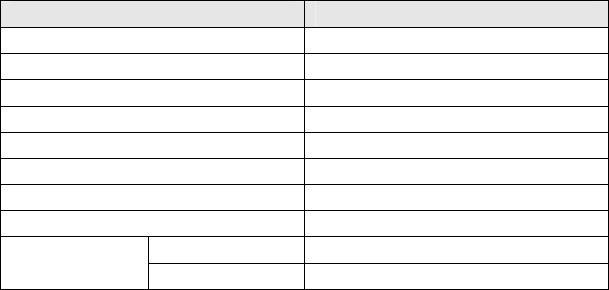
Two Channel UHF Cell Enhancer
User Handbook
Handbook Number: 50-187601HBKM Page: 15 of 51
4.2 Two-Way Splitter (07-002503)
4.2.1 Description
This wideband, 2 way hybrid splitter, is an AFL stock item with many years of reliable service. The
successful construction of such a device, relies largely on a PCB developed within a rigid
specification, skilled assembly and testing. Insertion loss quoted is typical, any unit will be within 5%
of this figure.
4.2.2 Technical Specification
PARAMETER SPECIFICATION
Frequency Range 50 – 500MHz
Split ratio 1:2
Insertion Loss 3.2dB (typical)
Isolation >20dB
Power rating 1.0 Watt
VSWR Better than 1.3:1
Available connectors BNC, N type, SMA
Weight 200gms (approximately)
operation: -20°C to +60°C
Temperature
range storage: -40°C to +70°C
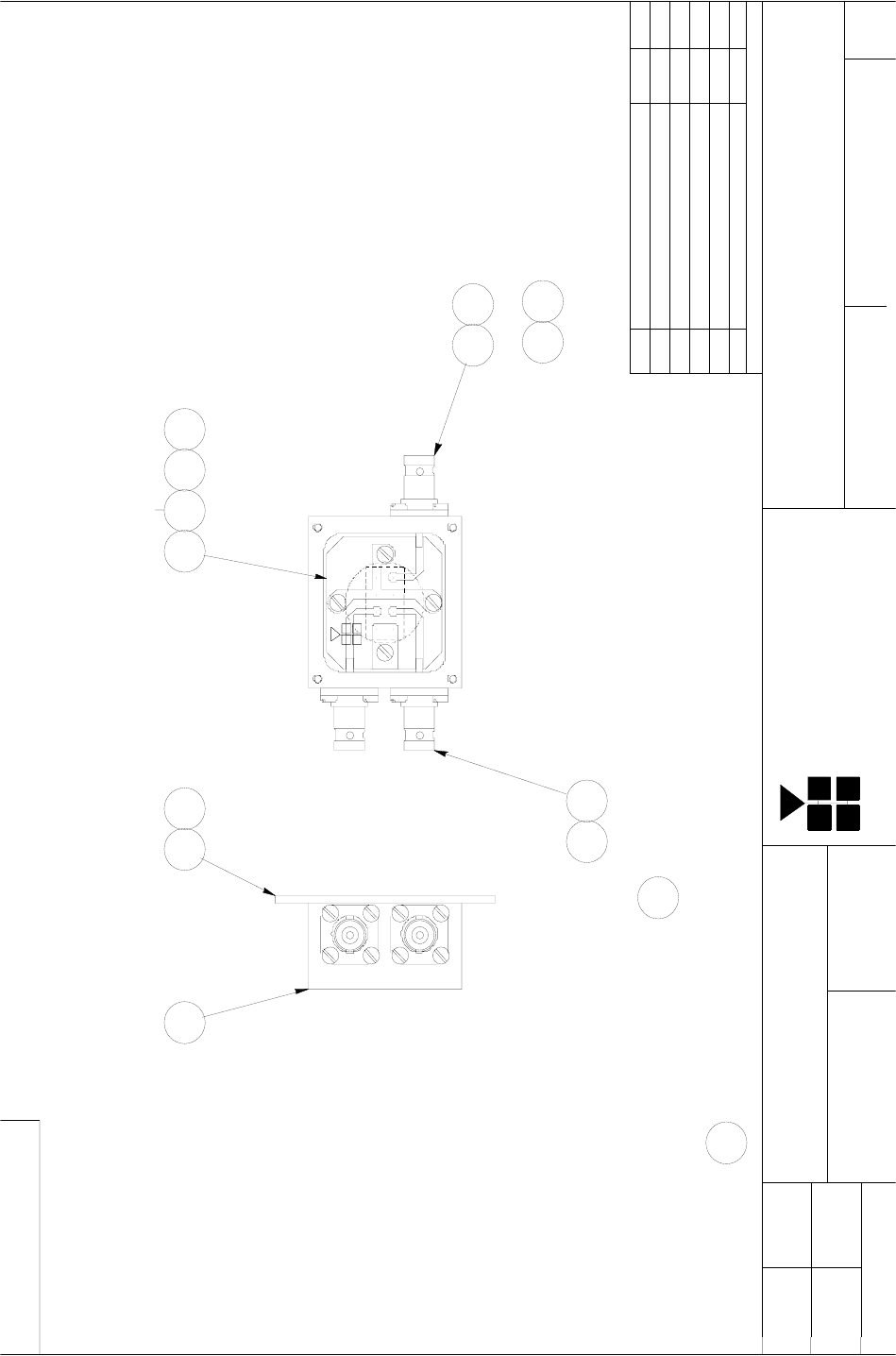
4.2.3 Drg. # 07-002501, 2 Way Splitter Assembly Drawing
BYDAT EDESCRIPTIO NNo
ISS UE
USED O N:
Fax (0494)764838
Little Chalfont(0494)763636
England
Aerial Facilities Ltd
ISSCUST O MER DRG .No
TITLE
SCALE
TWO DECIMAL PLACES ± 0.1mm
ONE DECIMAL PLACE ± 0.3mm
NO DECIM AL PL ACE ± 1 m m
TO L ERANCE S
BY AERIAL FACILITIES LTD.
PE RM ISSIBL E O NL Y IF EXPRESSL Y AUT HO RISED IN WRIT ING
REPRODUCTION OR USE OF THIS DESIGN BY OTHERS IS
THIS IS A PROPRIETARY DESIGN OF AERIAL FACILITIES L TD.
UNL ESS OTHERWISE STATED
AL L DIM ENSIO NS ARE IN m m
APPDCHKD
DAT E
DRAWN
2 WAY SPLITTER
GENERAL ASSEMBLY
07-002501 1A
1:1
DBS 04/06/93
1 PRODUCTION ISSUE
4/6/93
DBS
H1
Issu e 1
07-2525-3
Aer ial
Fa cilitie s Ltd
LID REMOVED FOR CLARITY
10
1
10
1
16
4
16
4
IN 2 POSNS
OR
11
1
16
4
513 16
4
20
FITTED FROM UNDERSIDE OF PCB
(BLUE MARKED PIN AT H1)
21 17
NOTES:
1. SOLDERING TO BE COMPLETED USING ITEM 26
*
*
(SOLDER SPLITTER CASE TO UNDERSIDE OF
BOARD-OPPOSITE POSITION MARKED: )
2. FIT ITEM TO COVER 2 SCREWS OF ITEM 2
8
PRODUCTION ISSUE (CR0962) 1A
4/12/98
RS
Two Channel UHF Cell Enhancer
User Handbook
Handbook Number: 50-187601HBKM Page: 16 of 51
Two Channel UHF Cell Enhancer
User Handbook
Handbook Number: 50-187601HBKM Page: 17 of 51
4.3 0.25Watt 0- -30dB Switched Attenuator (10-000703)
4.3.1 General Application
In many practical applications for Cell Enhancers etc., the gain in each path is found to be excessive.
Therefore, provision is made within the unit for the setting of attenuation in each path, to reduce the
gain.
4.3.2 Switched Attenuators
The AFL switched attenuators are available in two different types; 0 – 30dB in 2 dB steps (as in this
case), or 0 – 15dB in 1 dB steps. The attenuation is simply set using the four miniature toggle
switches on the top of each unit. Each switch is clearly marked with the attenuation it provides, and
the total attenuation in line is the sum of the values switched in. They are designed to maintain an
accurate 50Ω impedance over their operating frequency at both input and output.
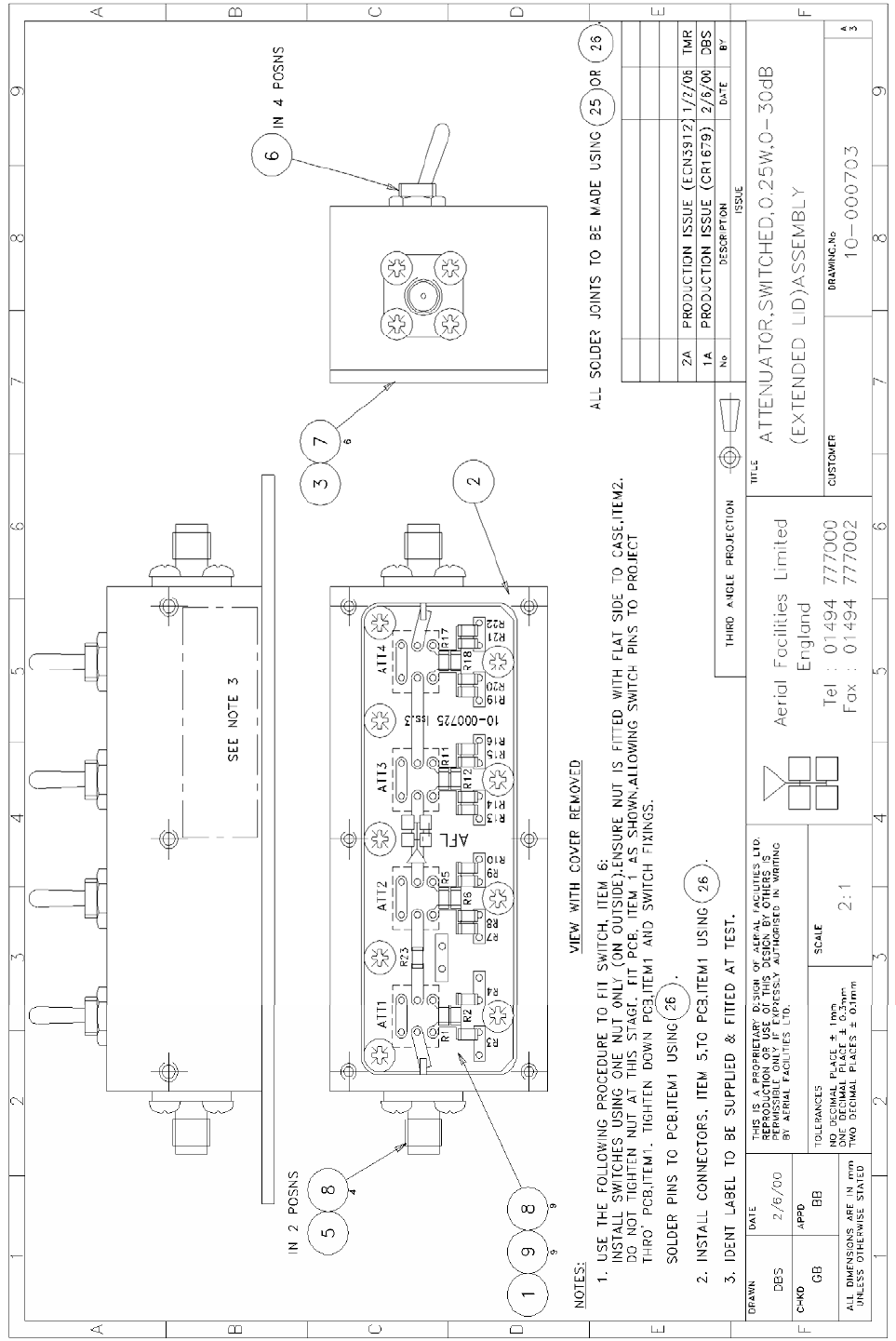
4.3.3 Switched Attenuator Assembly Drawing, Drg. # 10-000703
Two Channel UHF Cell Enhancer
User Handbook
Handbook Number: 50-187601HBKM Page: 18 of 51
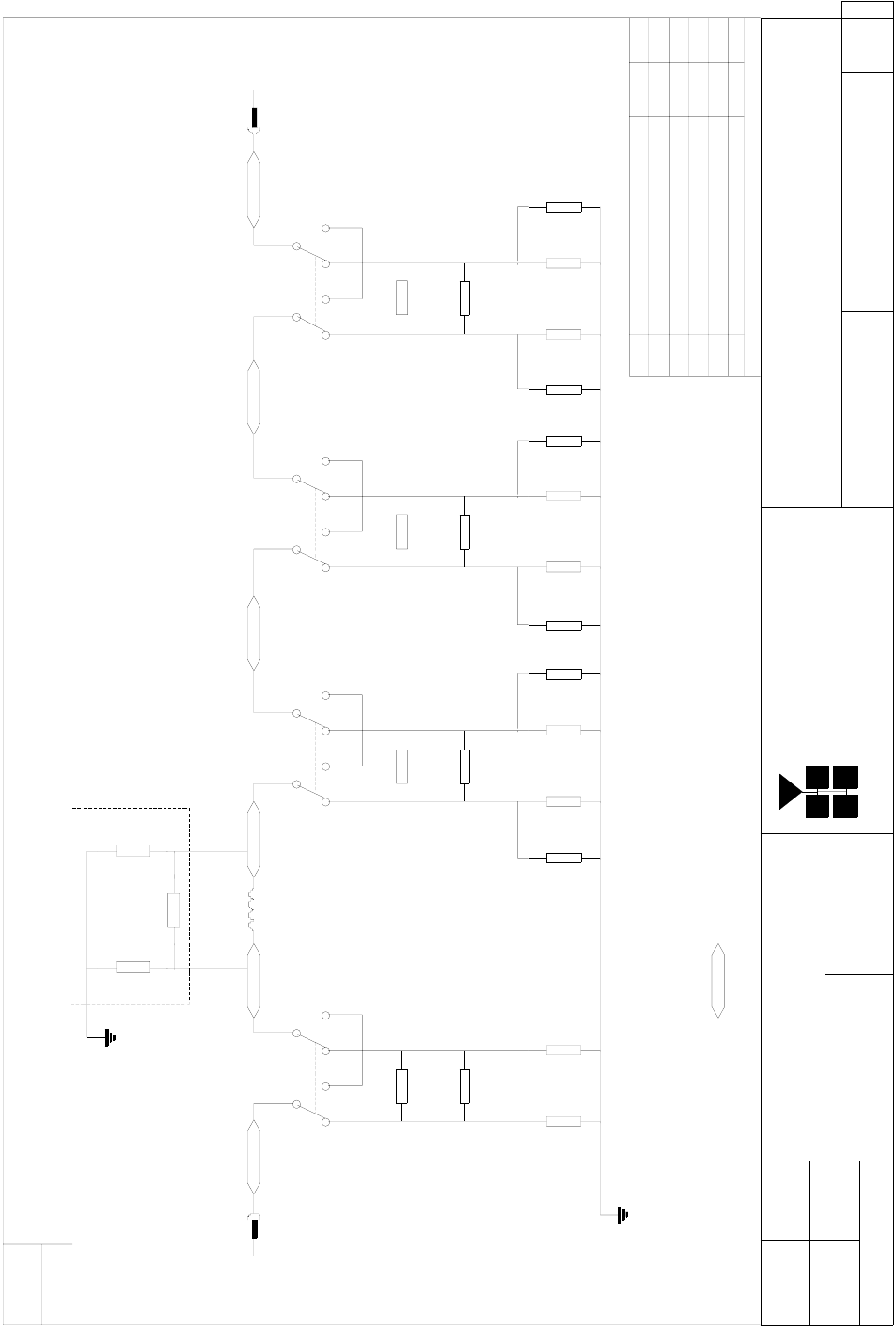
4.3.4 0-30dB Attenuator Circuit Diagram, Drg. # 10-000770
BYDATEDESCRIPTIONNo
ISSUE
USED O N
SELECT
ON TE ST
OPTIONA L ATTE NUA TION
RF IN RF OUT
ATT1 ATT2 ATT3 ATT4
R5 R1 1 R1 7
R3 R4 R8 R9 R1 4 R1 5 R2 0 R2 1
R2 4 R2 5
R2 3
LK1
R1 9R1 3R7 R2 2R1 6R1 0
R2 R6 R1 2 R1 8
R1
22R 47R 100R 270R
22R 47R 100R 330R
470R 470R 470R 470R 470R 470R 220R 270R 270R 220R 150R 150R 150R 150R
10-000702
1 PRODUCTION ISSUE (CR0482)
25/6/93
DBS
REFER TO PCB SUB-ASSEMBLY FOR FURTHER COMPONENT INFORMATION
AREAS SHOWN THUS: SIGNIFY 50 ohm STRIPLINE.
1A PRODUCTION ISSUE (CR0962)
21/1/99
SEW
Fax: (01494) 777002
Tel: (01494) 777000
Aerial Facilities Ltd
THIS IS A PROPRIETARY DESIGN OF AERIAL FACILITIES LTD.
REPRO DUCTIO N O R USE O F T HIS DESIG N BY O THERS IS
PERMISSIBLE O NLY IF EXPRESSLY AUTHORISED IN WRITING
BY AERIAL FACILITIES LTD.
NO DECIM AL PL ACE ± 1 mm
ONE DECIMAL PLACE ± 0.3mm
TWO DECIM AL PL ACES ± 0 .1m m
AL L DIMENSIO NS ARE IN mm
UNL ESS O THERWISE ST AT ED
CHKD
DRAWN
APPD
DATE
T O L ERANCES SCAL E
England
CUSTO MER DRG .No
TITLE
A
3
ISS
ATTENUATOR, SWITCHED, 0.25W, 0-30dB,
CIRCUIT DIAGRAM
10-000770 1A
DBS 25/06/93
10-000703
Two Channel UHF Cell Enhancer
User Handbook
Handbook Number: 50-187601HBKM Page: 19 of 51
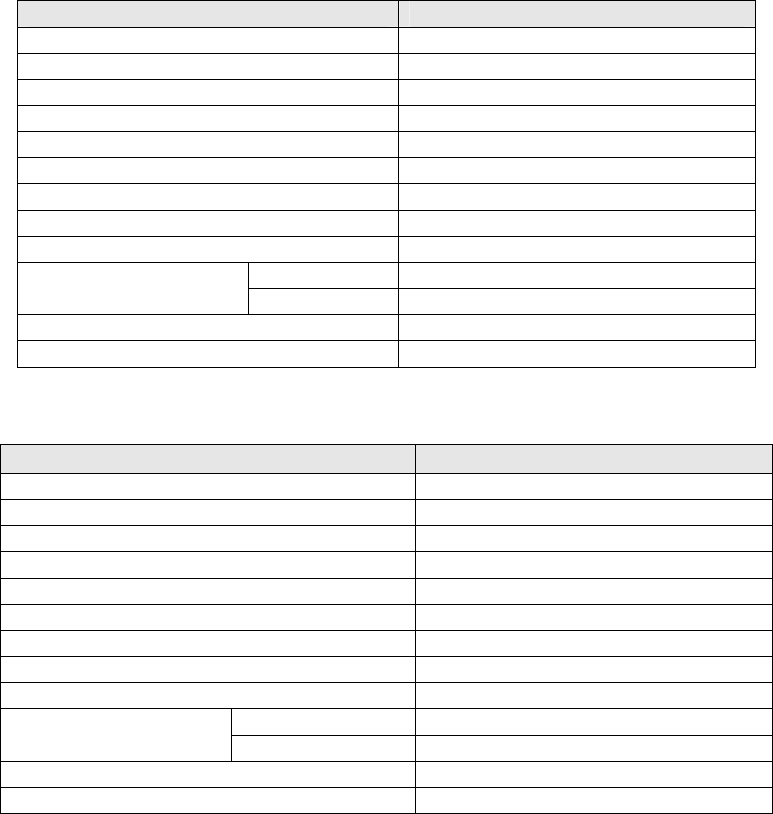
Two Channel UHF Cell Enhancer
User Handbook
Handbook Number: 50-187601HBKM Page: 20 of 51
4.4 11-007302 & 11-007402 Low Noise Amplifiers
4.4.1 Description
The low noise amplifiers used are double stage solid-state low-noise amplifiers. Class A circuitry is
used in the unit to ensure excellent linearity over a very wide dynamic range. The two active devices
are very moderately rated to provide a long trouble-free working life. There are no adjustments on
these amplifiers, and in the unlikely event of a failure then the entire amplifier should be replaced.
Note that the two amplifiers use similar DC/bias circuits.
4.4.2 Technical Specification (11-007302)
PARAMETER SPECIFICATION
Frequency range: 380-500MHz
Bandwidth: <140MHz
Gain: 20-22dB
1dB Compression point: +23.5dB (typical)
3rd order intercept: +36dB (typical)
Input/Output return loss: >20dB
Noise figure: <1.3dB
Connectors: SMA female
Supply: 200-230mA @ 24V DC
operational: -10°C to +60°C
Temperature range: storage: -20°C to +70°C
Weight: <300gm
Size: 90 x 55 x 30.2 (case only)
4.4.3 Technical Specification (11-007402)
PARAMETER SPECIFICATION
Frequency range: 380-500MHz
Bandwidth: <140MHz
Gain: 30-32dB
1dB Compression point: +22dBm (typical)
3rd order intercept: +34-35dBm (typical)
Input/Output return loss: >20dB
Noise figure: <1.3dB
Connectors: SMA female
Supply: 300-330mA @ 24V DC
operational: -10°C to +60°C
Temperature range: storage: -20°C to +70°C
Weight: 0.38kg
Size: 90 x 55 x 30.2 (case only)
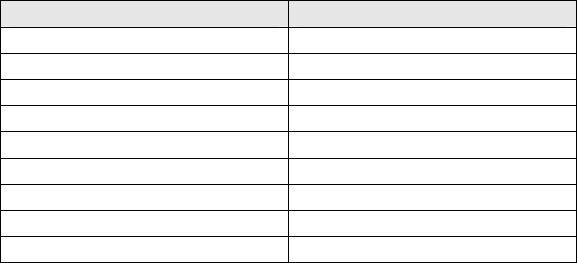
Two Channel UHF Cell Enhancer
User Handbook
Handbook Number: 50-187601HBKM Page: 21 of 51
4.4.4 LNA ‘D’ Connector Pin-out details
Connector pin Signal
1 +Ve input (10-24V)
2 GND
3 Alarm Relay O/P bad
4 Alarm Relay common
5 Alarm Relay good
6 No connection
7 TTL voltage set
8 TTL alarm/0V (good)
9 O/C good/0V bad
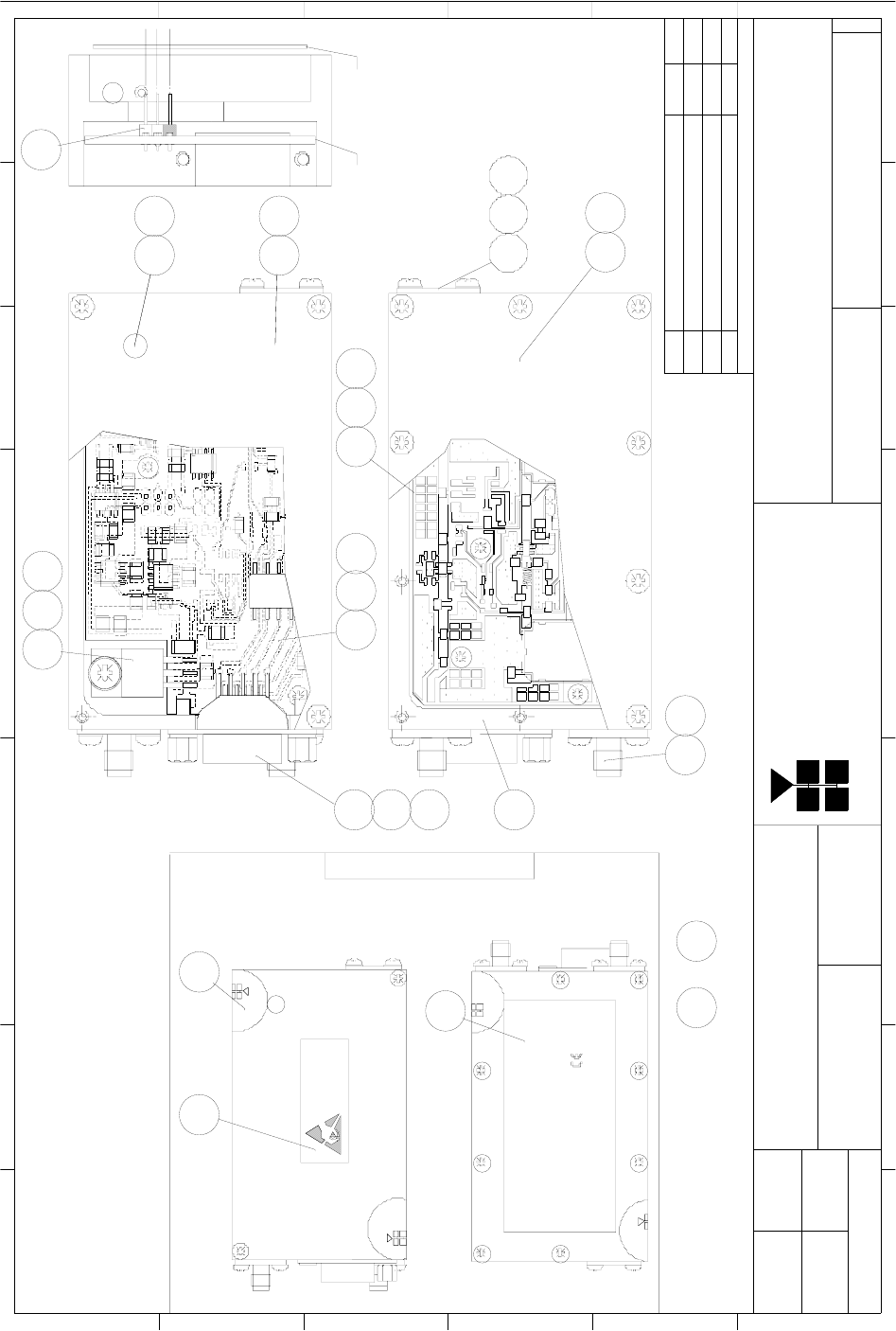
Two Channel UHF Cell Enhancer
User Handbook
Handbook Number: 50-187601HBKM Page: 22 of 51
4.4.5 Drg. # 11-007302, LNA Assembly With Alarm Relay
BYDATEDESCRIPTIO NNo
ISSUE
1 23 456 78 9
A
B
C
D
E
F
1
2
3
4
5
6
7
8
9
F
E
D
A
B
C
Fax : 01494 777002
Tel : 01494 777000
Aerial Facilities Ltd
TWO DECIMAL PL ACES ± 0 .1mm
ONE DECIMAL PL ACE ± 0.3mm
NO DECIM AL PL ACE ± 1m m
BY AERIAL FACILITIES LTD.
PERMISSIBLE ONLY IF EXPRESSLY AUTHORISED IN WRITING
REPRO DUCTIO N O R USE O F THIS DESIG N BY O THERS IS
THIS IS A PROPRIETARY DESIGN OF AERIAL FACIL ITIES LTD.
DRAWN
CHKD
AL L DIM ENSIO NS ARE IN m m
UNLESS OTHERWISE STATED
APPD
DATE
T O L ERANCES SCAL E
England
CUST O MER DRG .No
TITLE
A
3
LOW NOISE AMPLIFIER 380-500MHz
(20dB) ASSEMBLY DRAWING (WITH RELAY)
11-007302
1A
1.5:1
DBS 9/7/02
PRODUCTION IS SUE
9/7/02
DBS
COMPONENTS TO BE ADDED TO 11-003912,ITEM 15,DC PCB SUB-ASSEMBL Y
AFL
SENSITIVE
DEVICES
ELECTROSTATIC
OBSERVE PRECAUTIONS
ATTE NTION
FOR HANDLING
AFL
AFL
********
11-007302
380-500MHz
20dB 10-24V DC
**/**/20**
REF.
FREQ.
GAIN
S/N
DATE
0086
IN
34
see note 2
LABEL DETAILS - SCALE 1:1
35
see note 2
see note 2
31
IN 4 PLACES
2. LIDS,ITEMS 2 & 3 AND LABELS,ITEMS 31,34 & 35,TO BE FITTED ON TEST
1. SOLDER JOINTS TO BE MADE USING OR
2819
OUT
6
IN 3 PLACES
3
DC PCB
25
4
732
RF PCB
15
W6
21
2
C2
1
22
2
CPL 1
R1
C1
RF O UT
R1 9
W7
C2 1
5
C9
R2
R1 6
C5
L1
L3
C4 C8
+
R4
TR1
L5 C1 2
J31 J32
W5
W2 W1
225
10
17 24
2
33
2
27
5
27
2
20
2
16 23
5
24
2
IN 2 PLACES
4
26830
R3 9
REG 3
J3 J1J2
R5 0 R4 9
R4 4R4 3
RL 1
CO N1
CB IB
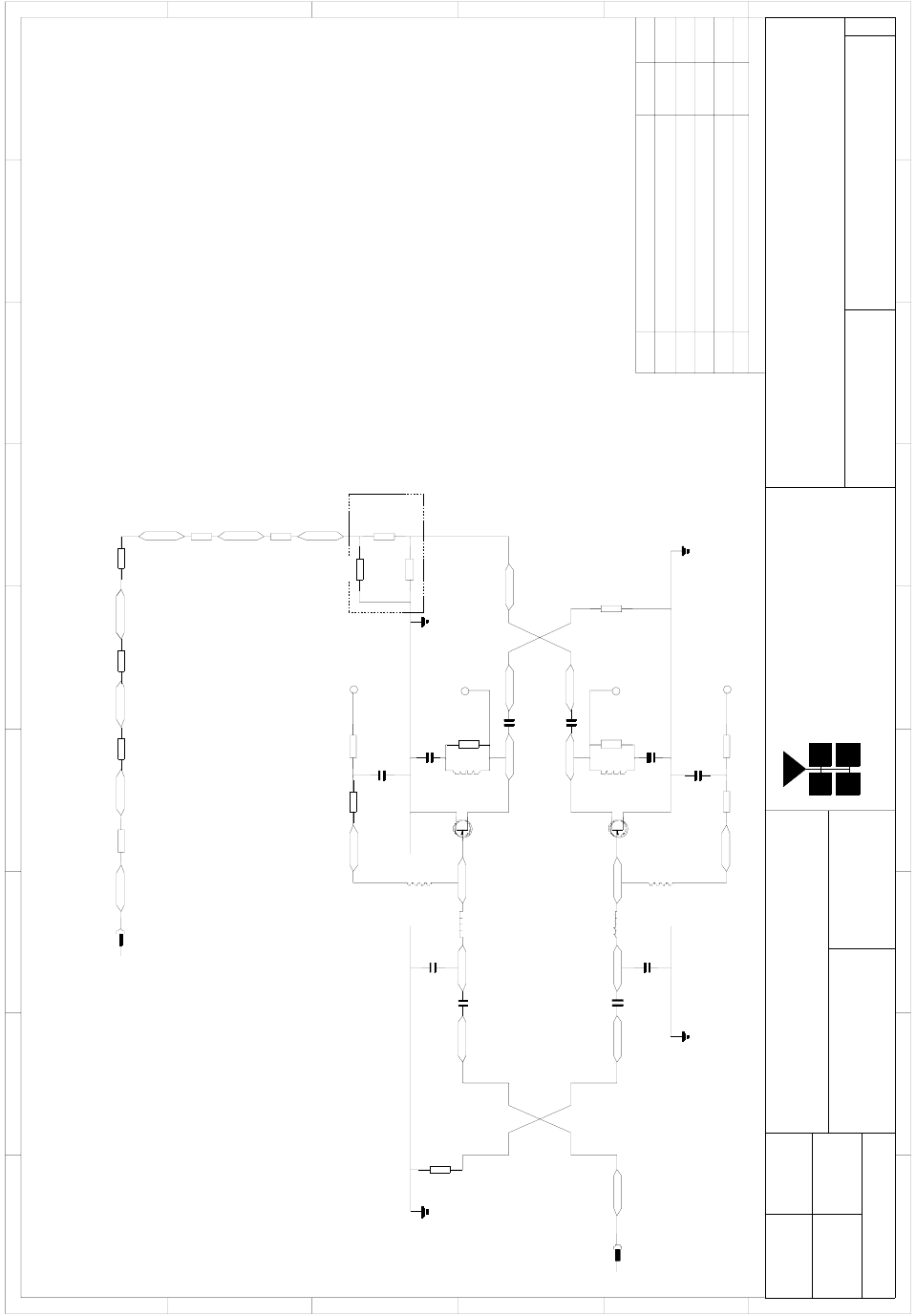
4.4.6 Drg. # 11-007370, LNA RF Circuit Diagram
BYDAT EDESCRIPT IO NNo
ISSUE
12
3456789
A
B
C
D
E
1 23456789
A
B
C
D
E
F
Fax : 01494 777002
Tel : 01494 777000
Aerial Facilities Limited
THIS IS A PROPRIETARY DESIGN OF AERIAL FACILITIES LTD.
REPRO DUCTIO N O R USE O F T HIS DESIG N BY O THERS IS
PERMISSIBLE ONLY IF EXPRESSLY AUTHORISED IN WRITING
BY AERIAL FACIL ITIES L TD.
NO DECIMAL PL ACE ± 1 m m
ONE DECIMAL PL ACE ± 0 .3mm
TWO DECIMAL PLACES ± 0 .1mm
AL L DIMENSIO NS ARE IN mm
UNL ESS O THERWISE STATED
CHKD
DRAWN
F
APPD
DAT E
T O L ERANCES SCALE
England
CUSTO MER DRAWING .No
TITLE
3
A
LOW NOISE AMPLIFIER 380-500MHz
(20dB) RF PCB CIRCUIT DIAGRAM
11-007370
1A
-
DBS 5/7/02
CLY2
TR 2
RF INPUT
R1
51R
11303- 3
CPL1
1nF
C3
Ø1.6x6 turns
L2
3. 3pF
C7
L4
330nH
R3
100R 10K
R6
1nF
C6
1nF
C1
C4
3. 3pF
Ø1.6x6 turns
L1
330nH
L3
100R
R2 R5
10K
J31
C5
1nF
TR 1
CLY2
560R
R7
100nH
L6
C10
1nF
C9
1nF
R4
560R
100nH
L5
1nF
C13
1nF
C12
51R
R8
11303- 3
CPL2
R9
R11
0R 0
R10
0R 0
W1
W5
0R 0
RF OUTPUT
0R 0
W6
0R 0
R19
HEADER PIN
HEADER PIN
J32
HEADER PIN
J12
HEADER PIN
J11
PRODUCTION ISSUE
5/7/02
DBS
0R 0
W2
0R 0
W7
AT T ENUATO R G RO UP
(Select values on Test)
D
G S
D
GS
ECN2718 DBS
19/9/02
2A
CB IB
Two Channel UHF Cell Enhancer
User Handbook
Handbook Number: 50-187601HBKM Page: 23 of 51
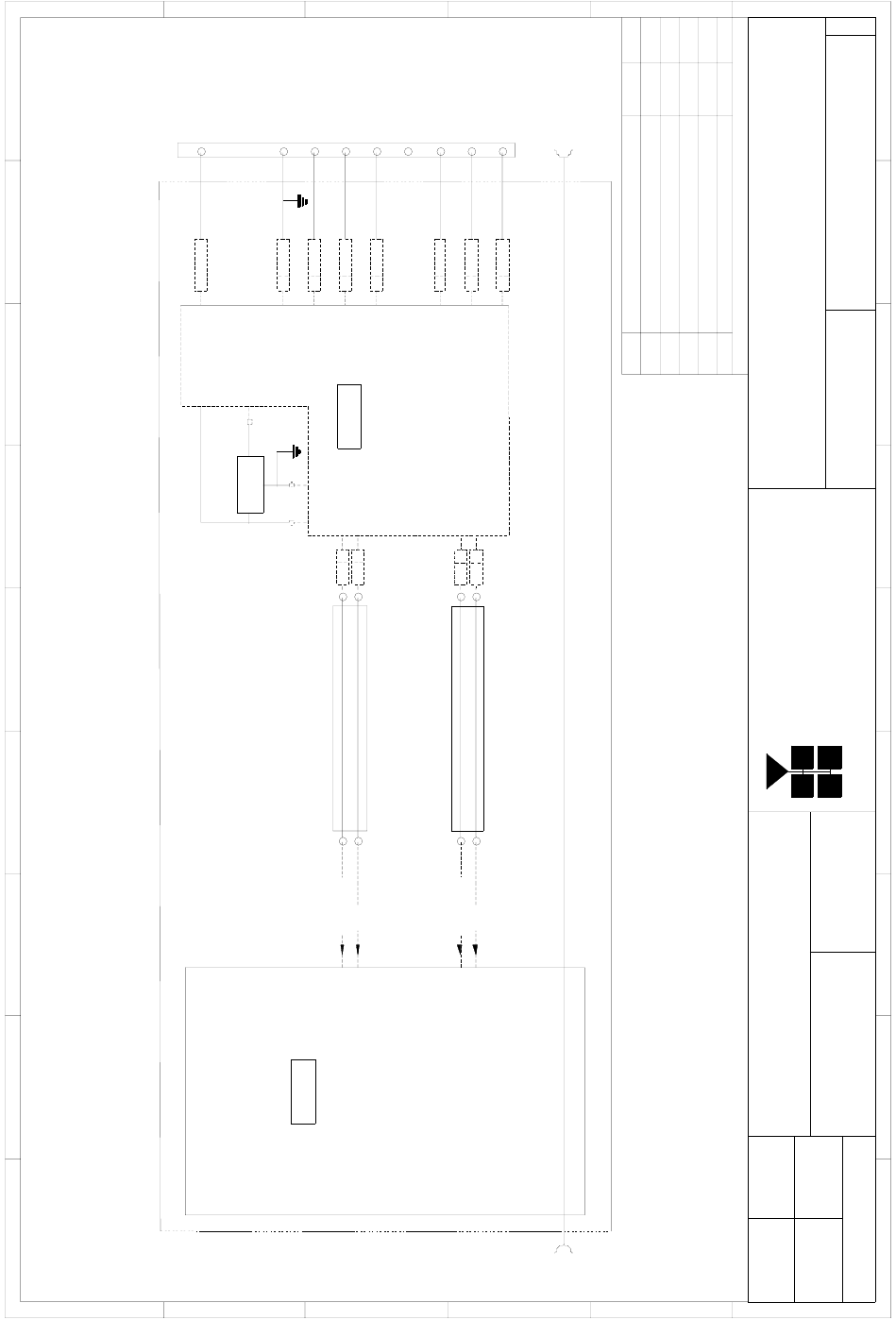
4.4.7 Drg. # 11-007371, LNA DC Wiring Diagram
BYDAT EDESCRIP T IO NNo
ISSUE
12
3456789
A
B
C
D
E
F
1 23456789
A
B
C
D
E
F
Fax : 01494 777002
Tel : 01494 777000
Aerial Facilities Limited
THIS IS A PROPRIETARY DESIG N OF AERIAL FACILITIES L TD.
REPRODUCTION OR USE OF THIS DESIGN BY OTHERS IS
PERM ISSIBL E O NL Y IF EXPRESSL Y A UT HO RISED IN WRIT ING
BY AERIAL FACILITIES L TD.
NO DECIM AL PL ACE ± 1 mm
ONE DECIMAL PLACE ± 0 .3mm
TWO DECIMAL PLACES ± 0 .1mm
ALL DIMENSIO NS ARE IN mm
UNLESS O THERWISE STATED
CHKD
DRAWN
APPD
DAT E
TO L ERANCES SCALE
England
CUST O M ER DRAWING .No
TITLE
3
A
LOW NOISE AMPLIFIER. 380-500MHz
(20dB) RF SCHEMATIC DIAGRAM
11-007371
1A
-
DBS 8/7/02
LM7808CT
REG 3
G
IO
-ve
J1 1 - J1 2
DC INPUT DC O UTPUT
RF PCB
FOR CIRCUIT DIAGRAM
SEE 11-007370
SEE 11-003971
FOR CIRCUIT DIAGRAM
DC PCB
+8V C
BA
RF
IN
PRODUCTION ISSUE
8/7/02
DBS
OUT
RF
O C G O O D/0 v B AD9 CO N1
9
REL AY CO NTACT G O O D
REL AY CO MM O N
REL AY CO NTACT BAD
PIN OUTS
9 WAY 'D'
TTL VOL TAGE SET
TTL AL ARM/0v GO O D
GROUND
10-24V DC I/P
7 CO N1
8 CO N1
5 CO N1
4 CO N1
6
8
7
5
4
A
3 CO N1
2 CO N1
3
2
CO N1
1
5V 75mA
-ve
J3 1 - J3 2
J31 1
J32 2
J12 2
J11 15V 75mA
CB IB
Two Channel UHF Cell Enhancer
User Handbook
Handbook Number: 50-187601HBKM Page: 24 of 51
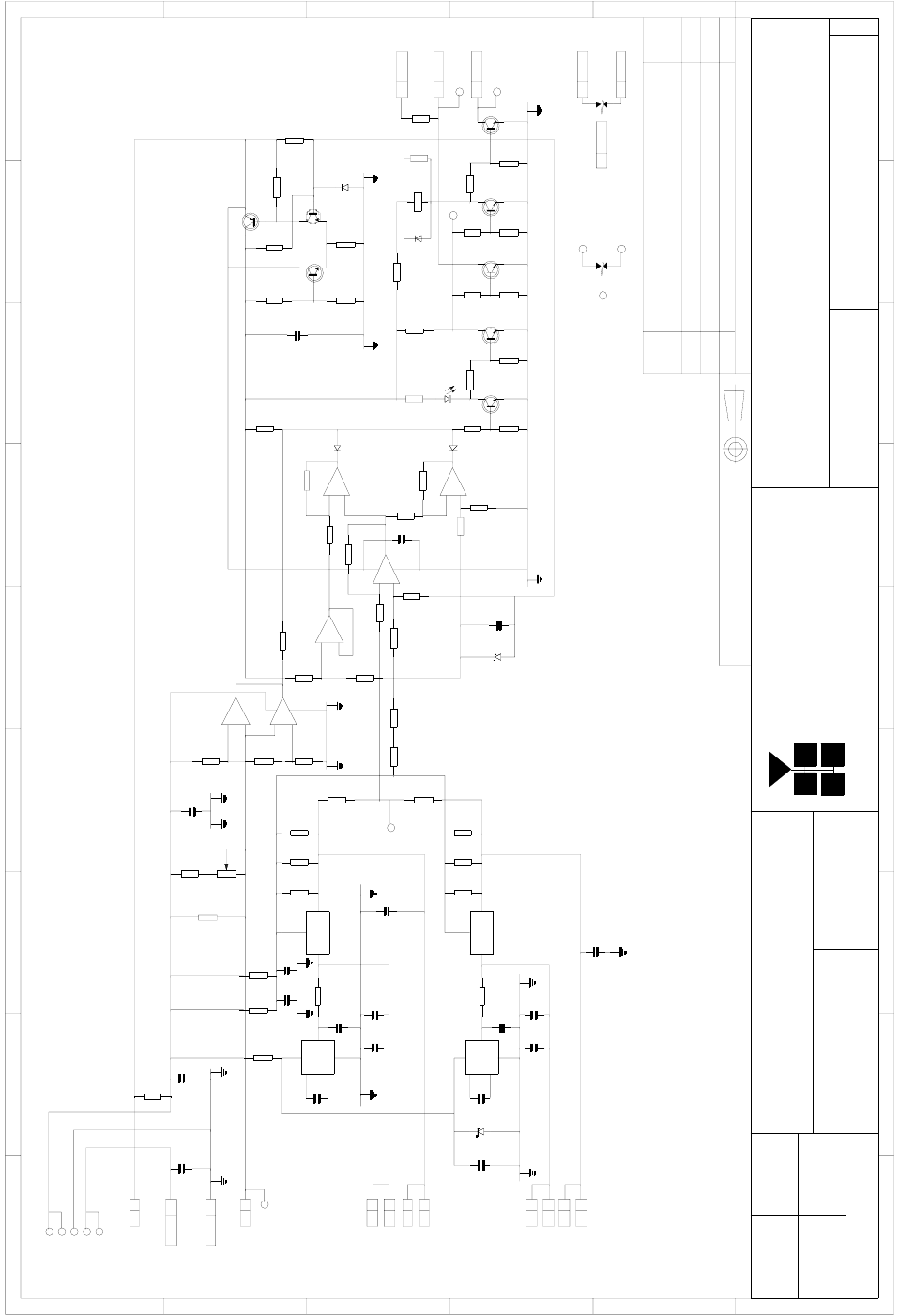
4.4.8 Drg. # 11-003971, LNA DC Circuit Diagram
BYDA T EDESCRIPTIONNo
ISSUE
12
3456789
A
B
C
D
E
F
1 23456789
A
B
C
D
E
F
Chesham(01494)778301
Fax (01494)778910
Aerial Facilities Limited
TWO DECIMAL PLACES ± 0.1mm
ONE DECIMAL PL ACE ± 0 .3mm
NO DECIM AL PL ACE ± 1m m
BY AERIAL FACILITIES LTD.
PERMISSIBLE ONLY IF EXPRESSLY AUTHORISED IN WRITING
REPRODUCTION OR USE OF THIS DESIGN BY OTHERS IS
THIS IS A PROPRIETARY DESIGN OF AERIAL FACILITIES LTD.
DRAWN
CHKD
UNLESS O THERWISE STATED
ALL DIMENSIO NS ARE IN mm
APPD
DAT E
TOLERANCES SCAL E
England
CUST O MER DRAWING .No
TITLE
A
3
DC PCB FOR LNA's AND LPA's,
CIRCUIT DIAGRAM
11-003971
DJL 24/09/01
PROTOTYPE ISSUEAA
24/9/01
DJL
THIRD ANG LE PROJECTION
R33
4K 7
TR 7
BCW71
R32
10K
BCW71
R31
4K 7
TR 8
R34
10K
R21
4K 7
R20
10K
TR 1
R24
BCW71
TR 2
R23
4K 7
R22
10K
TR 3
R25
4K 7
10K
BCW71
R11
120R
R12
3K 6
270K
R10
R9
1K
C2
100n
R6
100K
R4
100K
R8
270K
1K
R7
2
+C8
REG1
IO
A
1K
R47
+C4 +C5
R43 R44 R45
+C10
100n
C11
IC2
8
5
3
4
C15
10u
C17 +C16
100n
R52
+C14
3
4
IC3
28
5
R49
1K REG2
IO
A
R51 R50
+C13
R46
1K
R48
1K
R39 R40
R38
100R
R42
VR1
R41
+
-
1
2
3
-
+
5
6
7
-
2
+
3
1
R53
R54
R55
RL1
1
R35
1K
TR 4
TR 6
R16
1K
R17
2K 2
22K
R18
R19
560R
R15
2K 4
+
C3
R14
3K
R3
100K
R2
120R
100K
R5
R29
0R
1K 8
R1
4K 7
R36
56R
R27
R13
4K 7
TR 5
FZT751
BCW71
1U
BCW71
3V 3
D3
9-
+
10
8
12
+
-
13
14
6-
+
5
7
IC1:C
IC1:B
IC1:D
11
4
LM 324M
LM 324M
LM 324M
IC1:A
LM 324M
ZD 1
1. 23V
LL4148
D2 LE D 1
IC4:B
IC4:A
+
C12
1u
10u
+
C9
10u
1u 1u
>12V D C I / P
10u
ZD 3
5. 1V 10u
470R
R56
R57
D1
LL4148
CON 1 1
J2 2
9CON 1
CON 18
4CON 1
5CON 1
CON 13
RL1/1
ZD 2
C19
100n
4
8
LM 337LM
10u
10u
LL4148
1. * IF APPLICABLE, VALUES WILL BE DETERMINED AT A HIGHER LEVEL BOM
I C L7660C
I C L7660C
LM 337LM
2
J2 1
1J1
2J5
2J1
1J5
1J3
2J4
2J3
1J4
CON 1
+
C1
1u
C7
470p
+
C6
10u
+
C18
1u
2. CONNECTORS J1-5 TO BE FITTED AS NECESSARY
PRODUCTION ISSUE(ECN2359)
26/11/01
TAS1A
V_OUT
V_IN
B
C
A
*
**
***
***
*
P3
*
R58
7CON 1
R59
1K
CB IB
2A ECN2518
17/4/02
DJL
P5
P4
R L1/ 2 P8
P6
P7
P1
P2
R28
0R
*
*
*
*
*
*
*
*
3A ECN2686
25/7/02
DJL
Two Channel UHF Cell Enhancer
User Handbook
Handbook Number: 50-187601HBKM Page: 25 of 51
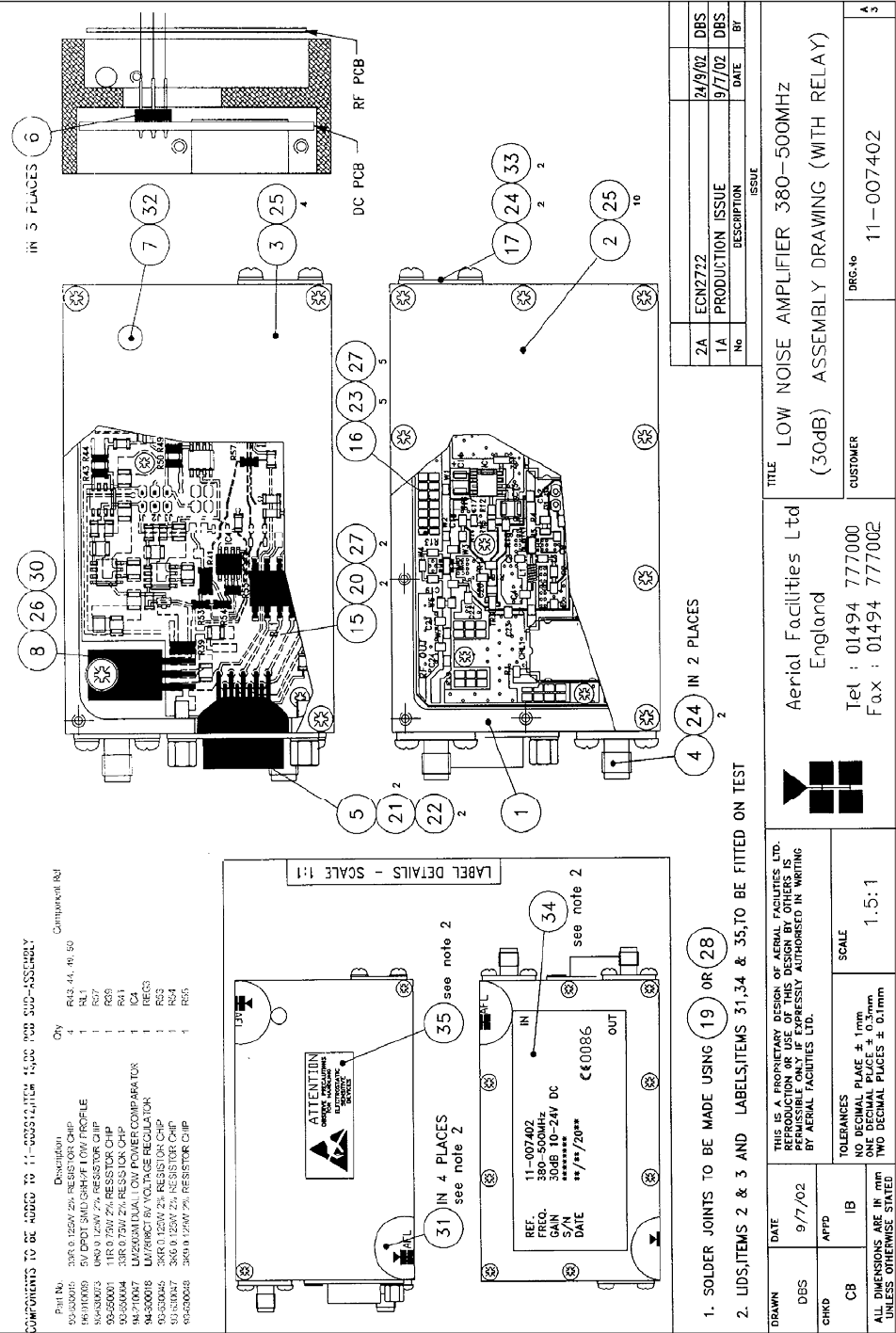
4.4.9 Drg. # 11-007402, LNA Assembly With Alarm Relay
Two Channel UHF Cell Enhancer
User Handbook
Handbook Number: 50-187601HBKM Page: 26 of 51
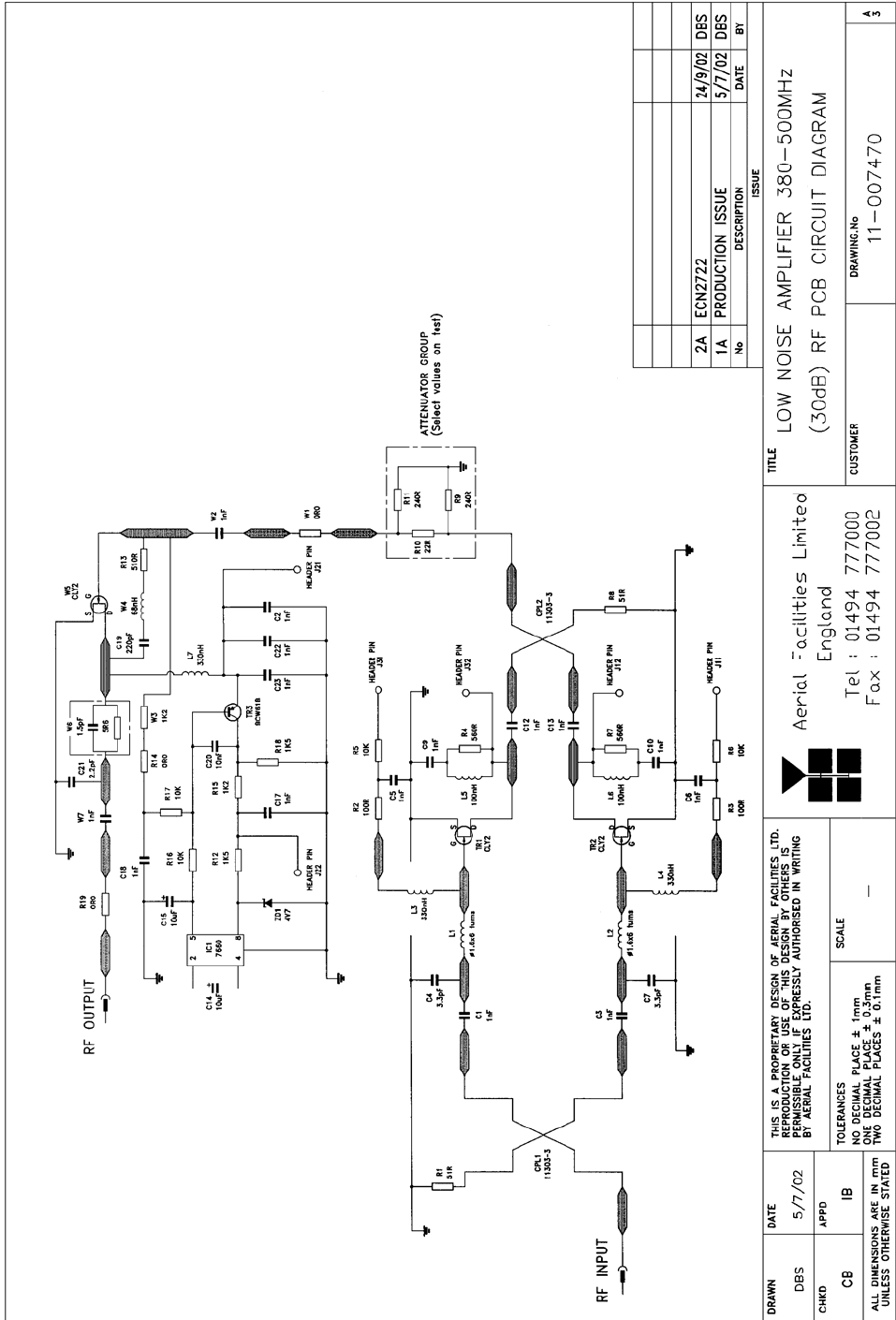
4.4.10 Drg. # 11-007470, LNA RF Circuit Diagram
Two Channel UHF Cell Enhancer
User Handbook
Handbook Number: 50-187601HBKM Page: 27 of 51
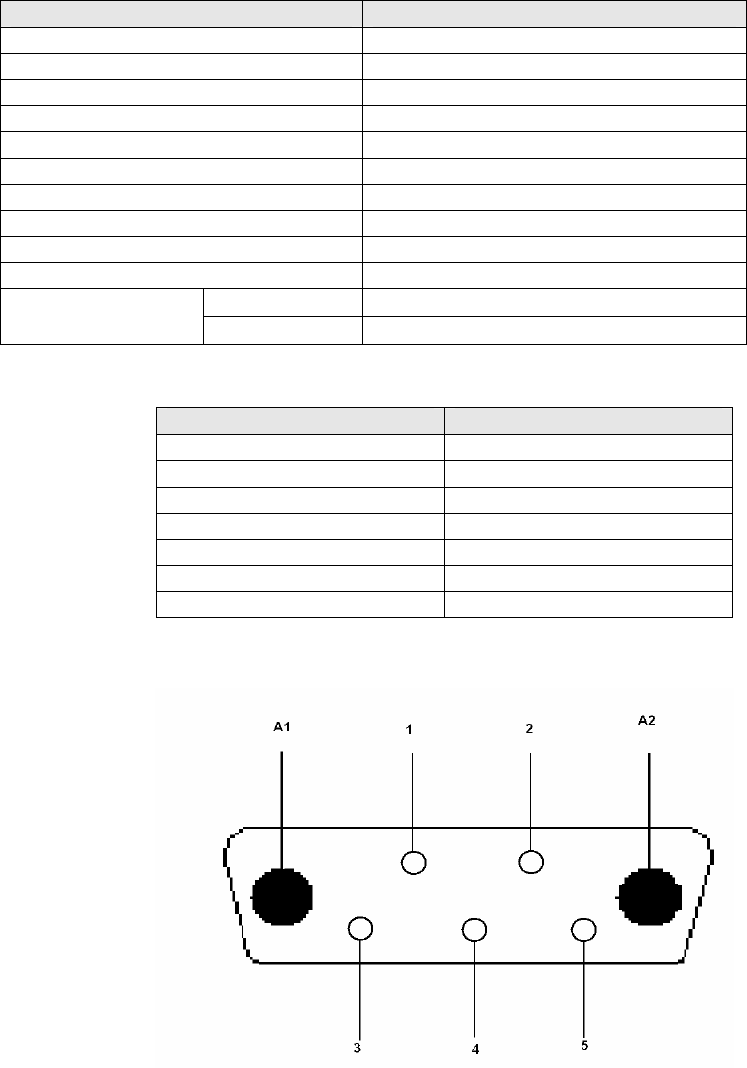
4.5 12-021601 5Watt Medium Power Tetra Amplifier
4.5.1 Description
The power amplifier fitted to this unit is a multi-stage, solid state power amplifier. Class A circuitry is
employed throughout the device to ensure excellent linearity over a wide dynamic frequency range.
All the semi-conductor devices are very conservatively rated to ensure low device junction
temperatures and a long, trouble free working lifetime.
The power amplifier should require no maintenance over its operating life. Under no circumstances
should the cover be removed or the side adjustments disturbed unless it is certain that the amplifier
has failed; since it is critically aligned during manufacture and any re-alignment will require extensive
test equipment.
4.5.2 Technical Specification
Two Channel UHF Cell Enhancer
User Handbook
Handbook Number: 50-187601HBKM Page: 28 of 51
PARAMETER SPECIFICATION
Frequency range: 380-470MHz (as required)
Bandwidth: 10-40MHz (typical, tuned to spec.)
Maximum RF output: >5Watts
Gain: >30dB
1dB compression point: +37.5dBm
3rd order intercept point: +50dBm
VSWR: better than 1.5:1
Connectors: SMA female
Supply: 1.9Amps @ 12V DC
Weight: 1kg (excluding heatsink)
operational: -10°C to +60°C Temperature
range: storage: -20°C to +70°C
4.5.3 PA 7-Way Connector Pin-outs
Connector Pin Signal
A1 (large pin) +12V DC
A2 (large pin) GND
1 Alarm relay common
2 TTL alarm/0V good
3 Alarm relay contact (bad)
4 Alarm relay contact (good)
5 O/C good/0V bad (TTL)
4.5.4 PA Connector Pin-Outs
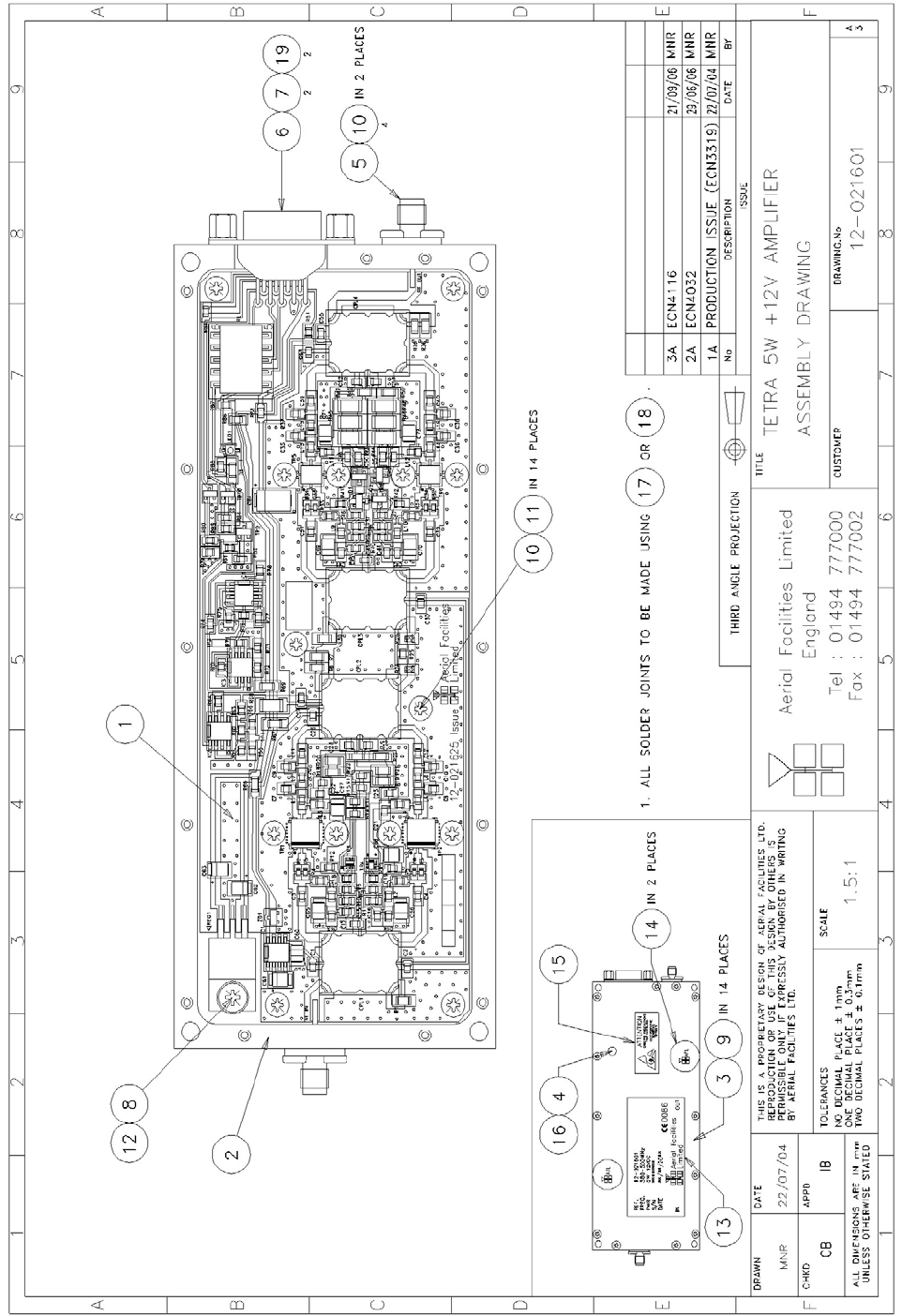
4.5.5 5W TETRA PA Assembly Drawing, Drg. # 12-021601
Two Channel UHF Cell Enhancer
User Handbook
Handbook Number: 50-187601HBKM Page: 29 of 51
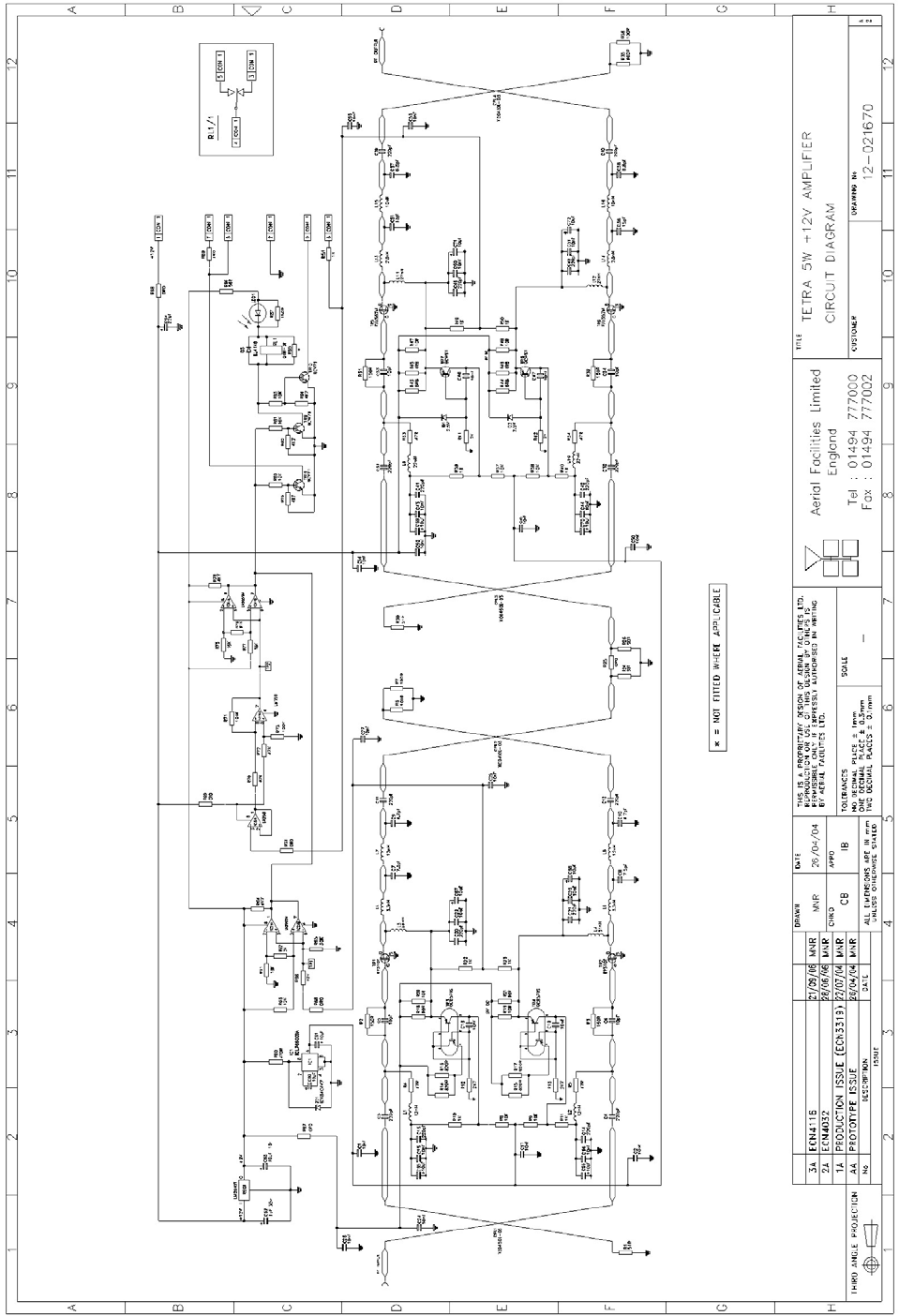
4.5.6 5W TETRA PA Circuit Diagram, Drg. # 12-021670
Two Channel UHF Cell Enhancer
User Handbook
Handbook Number: 50-187601HBKM Page: 30 of 51
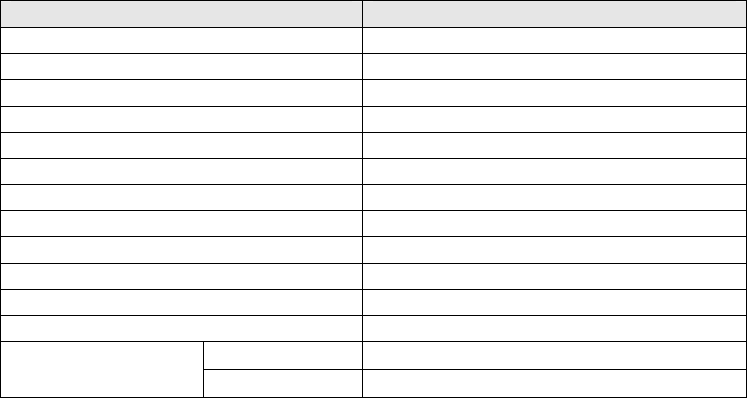
Two Channel UHF Cell Enhancer
User Handbook
Handbook Number: 50-187601HBKM Page: 31 of 51
4.6 12-022101 10Watt Power Tetra Amplifier
4.6.1 Description
The power amplifier fitted to this unit is a multi-stage, solid state power amplifier. Class A circuitry is
employed throughout the device to ensure excellent linearity over a wide dynamic frequency range.
All the semi-conductor devices are very conservatively rated to ensure low device junction
temperatures and a long, trouble free working lifetime.
The power amplifier should require no maintenance over its operating life. Under no circumstances
should the cover be removed or the side adjustments disturbed unless it is certain that the amplifier
has failed; since it is critically aligned during manufacture and any re-alignment will require extensive
test equipment.
4.6.2 Technical Specification
PARAMETER SPECIFICATION
Frequency range: 380-470MHz (as required)
Bandwidth: 10-40MHz (typical, tuned to spec.)
Maximum RF output: >10Watts
Gain: >34dB
1dB compression point: +40.3dBm
3rd order intercept point: +54dBm
Return loss: >18dB
VSWR: better than 1.5:1
Connectors: SMA female
Supply: 4.3A @ 12V DC
Weight: 1kg (excluding heatsink)
Alarm: Load current alarm (relay contacts)
operational: -10°C to +60°C Temperature
range: storage: -20°C to +70°C
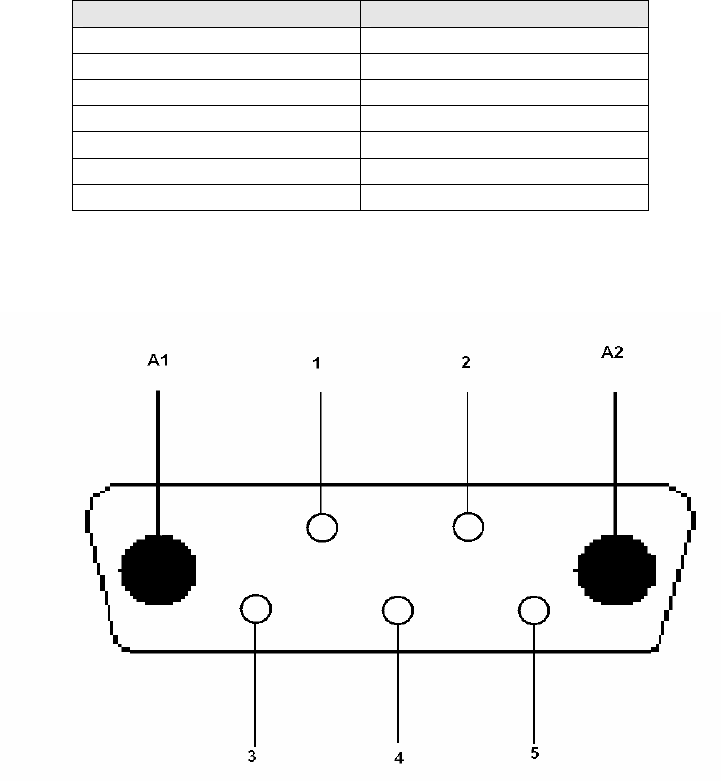
4.6.3 PA 7-Way Connector Pin-Outs
Two Channel UHF Cell Enhancer
User Handbook
Handbook Number: 50-187601HBKM Page: 32 of 51
Connector Pin Signal
A1 (large pin) +12V DC
A2 (large pin) GND
1 Alarm relay common
2 TTL alarm/0V good
3 Alarm relay contact (bad)
4 Alarm relay contact (good)
5 O/C good/0V bad (TTL)
4.6.4 PA Connector Pictorial Pin-Outs
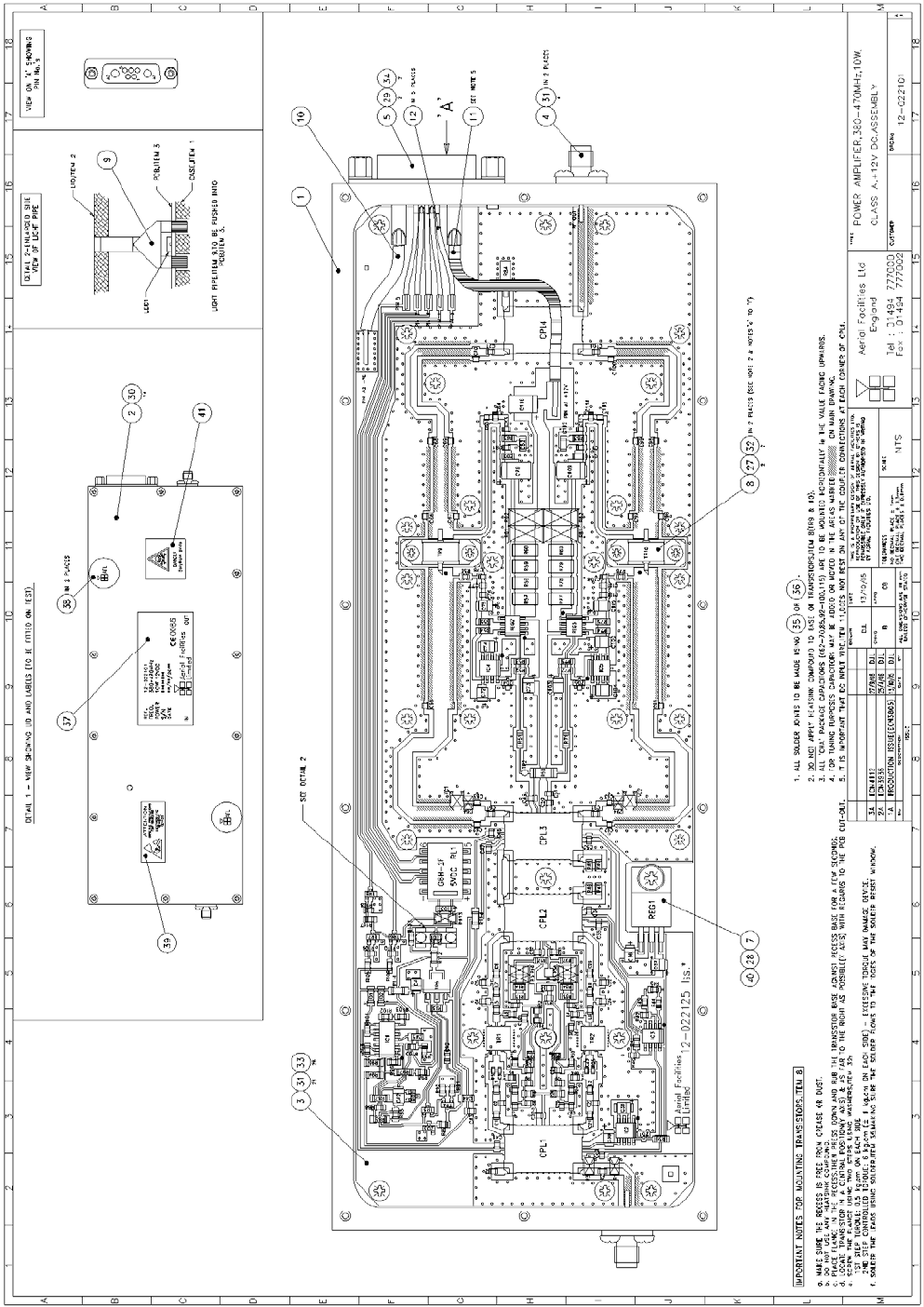
4.6.5 10Watt PA Assembly Drawing, Drg. # 12-022101
Two Channel UHF Cell Enhancer
User Handbook
Handbook Number: 50-187601HBKM Page: 33 of 51
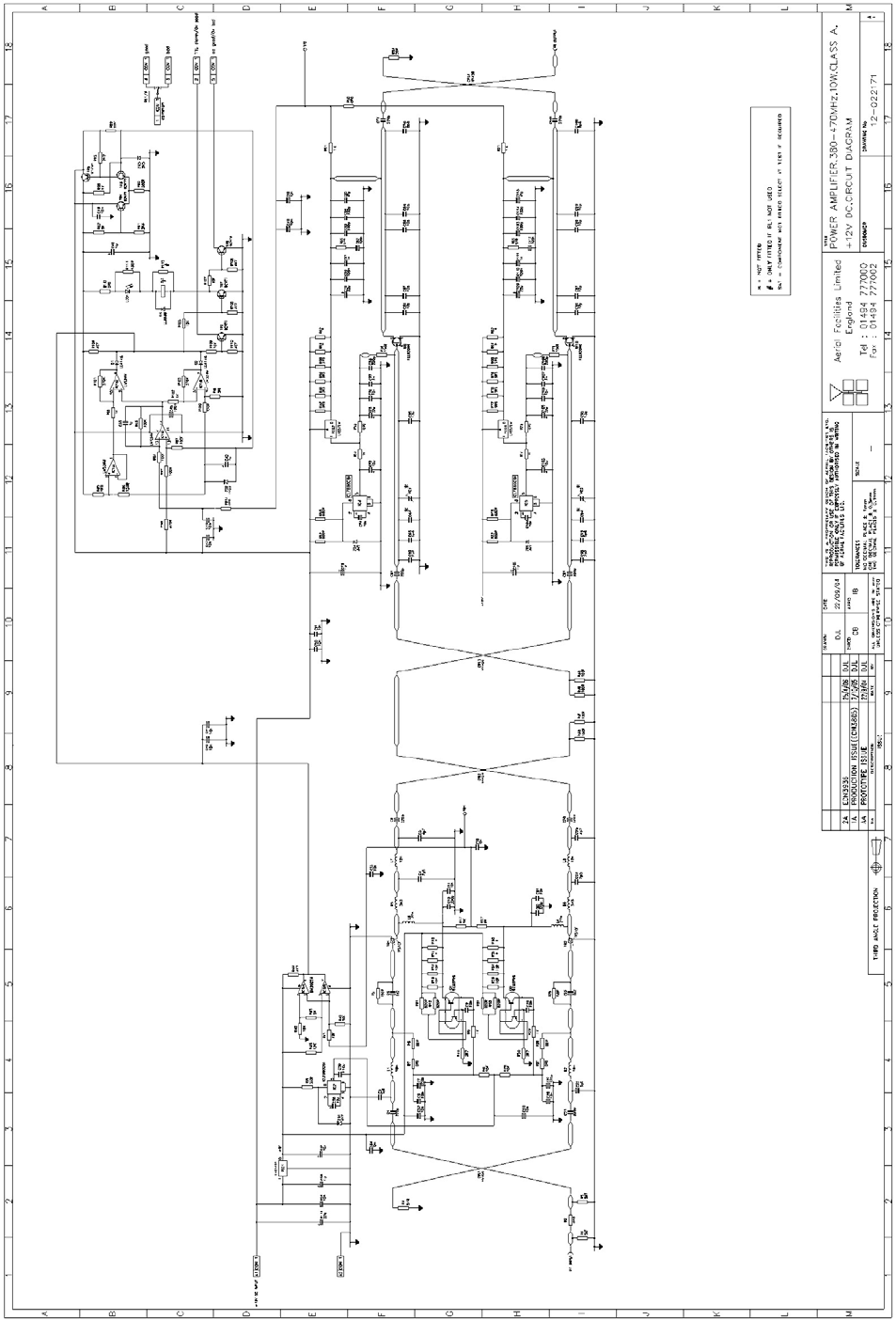
4.6.6 10Watt PA Circuit Diagram, Drg. # 12-022171
Two Channel UHF Cell Enhancer
User Handbook
Handbook Number: 50-187601HBKM Page: 34 of 51
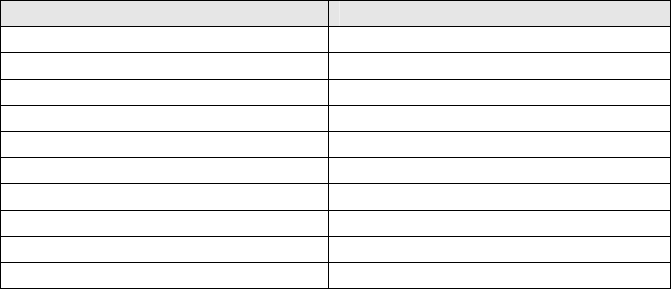
Two Channel UHF Cell Enhancer
User Handbook
Handbook Number: 50-187601HBKM Page: 35 of 51
4.7 8A Mains Filter Assembly (13-003301)
4.7.1 Description
The AFL 10A mains filter assembly has been designed to remove mains-borne interference caused
by external electrical radiation.
Many filters exist which partially satisfy the criteria needed for cell enhancer power supplies (the main
criteria being high continuous current) but a more cost efficient solution was realized using AFL’s own
manufacturing capability.
4.7.2 Technical Specification
PARAMETER SPECIFICATION
Maximum surge current: 6.5kA (8/20)
Maximum leakage current: <0.3mA (@ working voltage
Maximum continuous current: 8A
Maximum continuous voltage: 253V
Working voltage: 230V (nominal)
Impulse energy absorption: 420J
Ambient temperature limits: -25°C to +85°C
Humidity: 5-95% (non-condensing)
Case material: ABS plastic (IP50 rated)
Maximum attenuation: 70dB (common mode 50-60Hz)
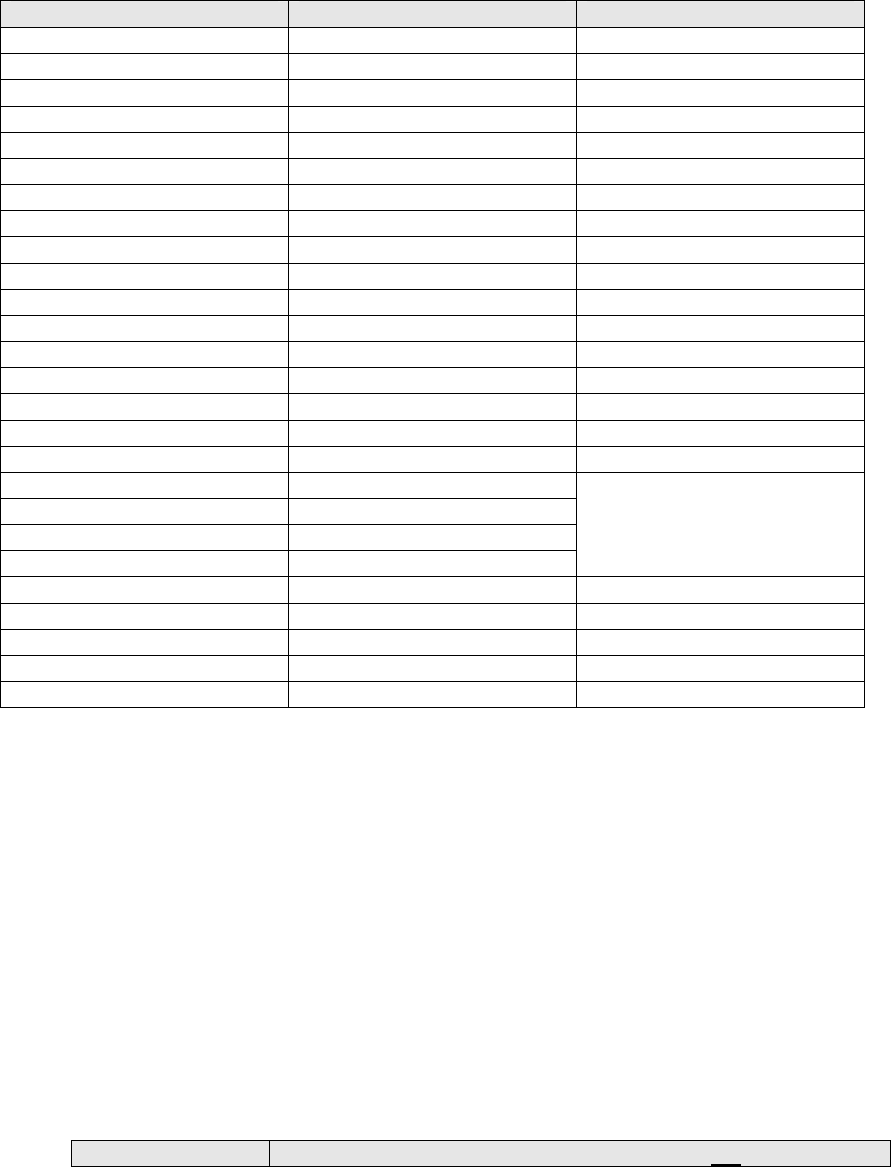
Two Channel UHF Cell Enhancer
User Handbook
Handbook Number: 50-187601HBKM Page: 36 of 51
4.8 Channel Control Module (17-002101)
4.8.1 Description
The purpose of the channel control modules is to change the channel selective module frequencies
by means of a series of D.I.P switch banks, each switch corresponding to a different ‘frequency bit’.
4.8.2 Technical Specification
Below shows the pin assignments for each switch on a channel control module.
IDC PIN 25-way Connector Function
1 13 Freq. bit 1 (12.5kHz)
2 25 Freq. bit 2 (25kHz)
3 12 Freq. bit 3 (50kHz)
4 24 Freq. bit 4 (100kHz)
5 11 Freq. bit 5 (200kHz)
6 23 Freq. bit 6 (400kHz)
7 10 Freq. bit 7 (800kHz)
8 22 Freq. bit 8 (1.6MHz)
9 9 Freq. bit 9 (3.2MHz)
10 21 Freq. bit 10 (6.4MHz)
11 8 Freq. bit 11 (12.8MHz)
12 20 Freq. bit 12 (25.6MHz)
13 7 Freq. bit 13 (51.2MHz)
14 19 Freq. bit 14 (102.4MHz)
15 6 Freq. bit 15 (204.8MHz)
16 18 Freq. bit 16 (409.6MHz)
17 5 Module alarm
18 17
19 4
20 16
21 3
N/C
22 15 +5V
23 2 0V
24 14 Switched 12V
25 1 0V
26 --- ---
4.8.3 VHF/ UHF Programming Procedure
Check that the required frequency falls within the operational frequency limits of the Cell Enhancer.
For each channel required, subtract the synthesiser offset from the required operating frequency and
record the resulting local oscillator frequency.
Divide each local oscillator frequency by the channel spacing and check that the result is an integer
(i.e.: no remainder).
If the synthesiser division ratio is not an integer value, check the required operational frequency and
repeat the calculation checking for mistakes.
Convert the required local oscillator frequency to synthesiser programming switch state patterns
according to the following table.
Switch number Synthesiser offset added when switch in UP position
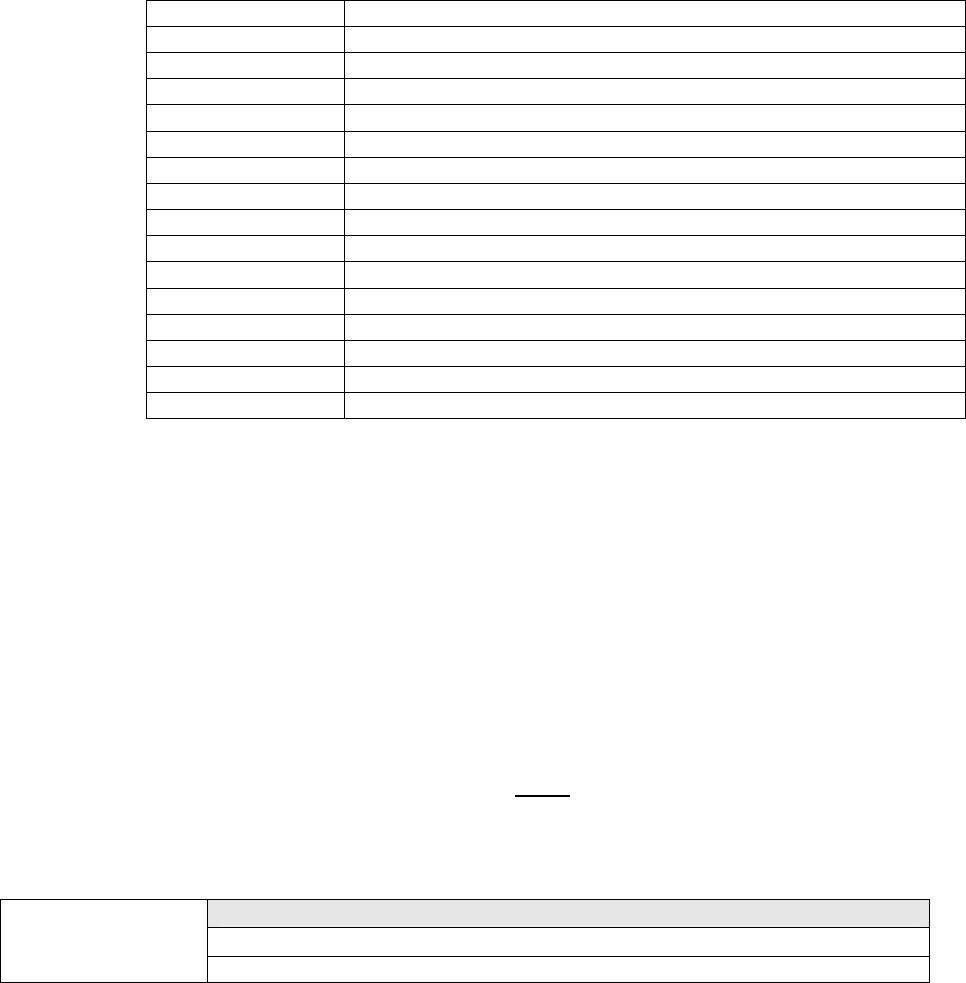
Two Channel UHF Cell Enhancer
User Handbook
Handbook Number: 50-187601HBKM Page: 37 of 51
1 +12.5kHz
2 +25kHz
3 +50kHz
4 +100kHz
5 +200kHz
6 +400kHz
7 +800kHz
8 +1.6MHz
9 +3.2MHz
10 +6.4MHz
11 +12.8MHz
12 +25.6MHz
13 +51.2MHz
14 +102.4MHz
15 +204.8MHz
16 +409.6MHz
4.8.4 VHF/ UHF Programming Example
Frequency required: 465.5MHz
Channel spacing: 12.5kHz
Synthesiser offset: 21.4MHz
The Local Oscillator frequency is therefore: 465.4 – 21.4 = 444.0 MHz
Dividing the LO frequency
by the channel spacing of: 0.0125MHz:
444.0 = 35520
0.0125
This is an integer value, therefore it is OK to proceed.
Switch settings
16 15 14 13 12 11 10 9 8 7 6 5 4 3 2 1
Local Oscillator
Frequency of:
444.0 MHz 1 0 0 0 1 0 1 0 1 1 0 0 0 0 0 0
Switch setting: 0 = switch DOWN (on, frequency ignored)
1 = switch UP (off, frequency added)
Two Channel UHF Cell Enhancer
User Handbook
Handbook Number: 50-187601HBKM Page: 38 of 51
4.9 Channel Selective Module (17-003007)
4.9.1 Description
The channel selectivity module is employed when the Cell Enhancer requirement dictates that very
narrow bandwidths (single operating channels), must be selected from within the operating passband.
One channel selectivity module is required for each channel.
The Channel Selectivity Module is an Up/Down frequency converter that mixes the incoming channel
frequency with a synthesised local oscillator, so that it is down-converted to an Intermediate
Frequency (IF) in the upper HF range. An eight pole crystal filter in the IF amplifier provides the
required selectivity to define the operating passband of the Cell Enhancer to a single PMR channel.
The same local oscillator then converts the selected IF signal back to the channel frequency.
Selectivity is obtained from a fixed bandwidth block filter operating at an intermediate frequency (IF) in
the low VHF range. This filter may be internal to the channel selectivity module (Crystal or SAW filter)
or an externally mounted bandpass filter, (LC or Helical Resonator). Various IF bandwidths can
therefore be accommodated. A synthesized Local Oscillator is employed in conjunction with high
performance frequency mixers, to translate between the signal frequency and IF.
The operating frequency of each channel selectivity module is set by the programming of channel
selectivity module frequencies and is achieved digitally, via hard wired links, banks of DIP switches, or
via an onboard RS232 control module, providing the ability to remotely set channel frequencies.
Automatic Level Control (ALC) is provided within each channel selectivity module such that the output
level is held constant for high level input signals. This feature prevents saturation of the output mixer
and of the associated amplifiers.
Alarms within the module inhibit the channel if the synthesised frequency is not locked. The
synthesiser will not usually go out of lock unless a frequency far out of band is programmed.
The channel selectivity module is extremely complex and, with the exception of channel frequency
programming within the design bandwidth, it cannot be adjusted or repaired without extensive
laboratory facilities and the necessary specialised personnel. If a fault is suspected with any channel
selectivity module it should be tested by substitution and the complete, suspect module should then
be returned to AFL for investigation.
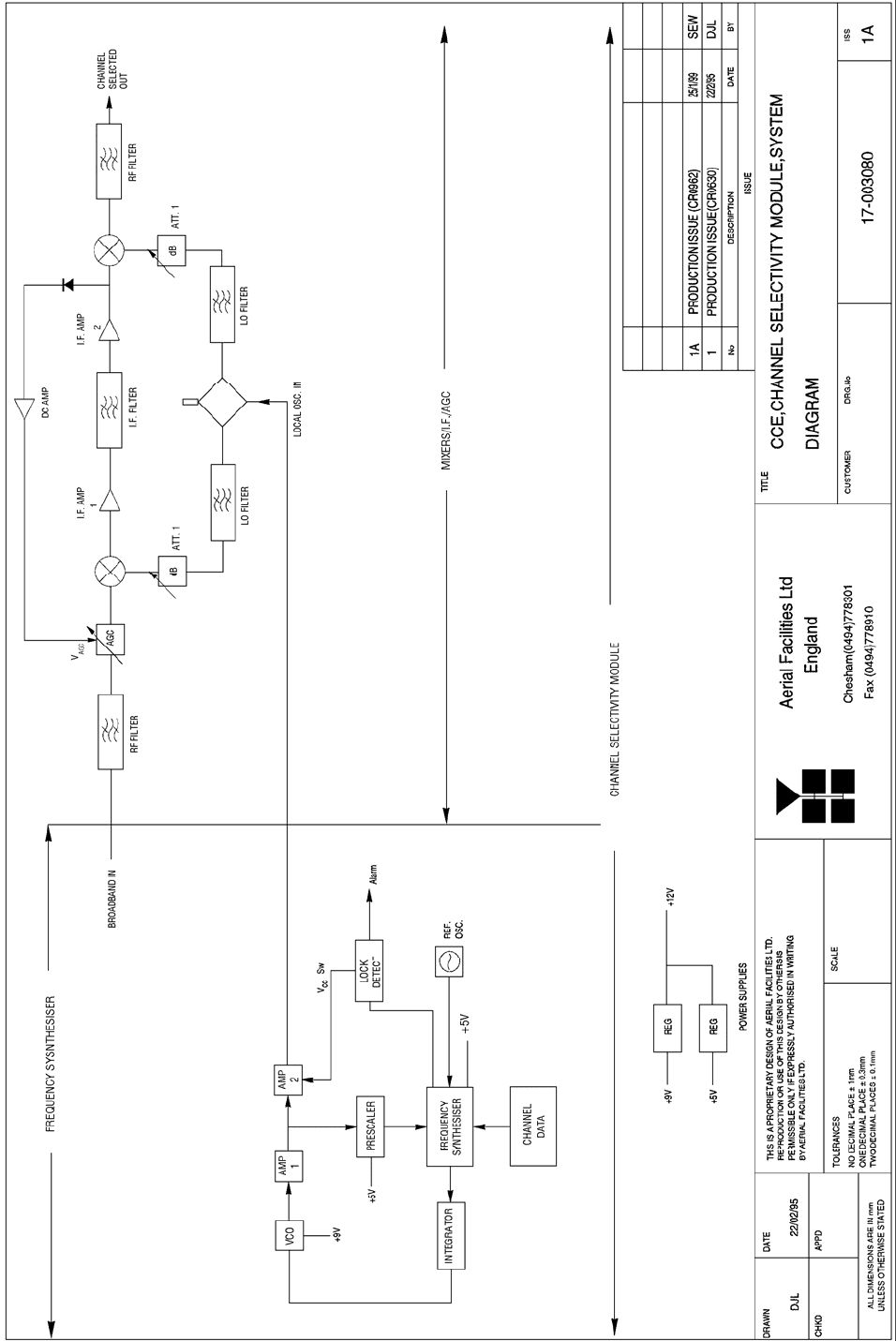
4.9.2 Generic Channel Module Block Diagram, Drg. # 17-003080
Two Channel UHF Cell Enhancer
User Handbook
Handbook Number: 50-187601HBKM Page: 39 of 51
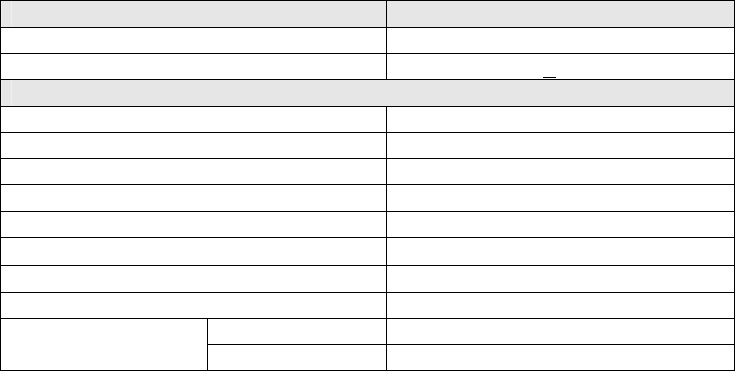
Two Channel UHF Cell Enhancer
User Handbook
Handbook Number: 50-187601HBKM Page: 40 of 51
4.10 12V Single Relay Board (80-008901)
4.10.1 Description
The General Purpose Relay Board allows the inversion of signals and the isolation of circuits. It is
equipped with a single dual pole change-over relay RL1, with completely isolated wiring, accessed
via a 15 way in-line connector.
The relay is provided with polarity protection diodes and diodes for suppressing the transients caused
by "flywheel effect" which can destroy switching transistors or induce spikes on neighbouring circuits.
It’s common use is to amalgamate all the alarm signals into one, volts-free relay contact pair for the
main alarm system.
Note that the board is available for different voltages (12 or 24V) depending on the type of relay fitted
at RL1.
4.10.2 Technical Specification
PARAMETER SPECIFICATION
Operating voltage: 8 to 30V (floating earth)
Alarm threshold: Vcc - 1.20 volt +15%
Alarm output relay contacts:
Max. switch current: 1.0Amp
Max. switch volts: 120Vdc/60VA
Max. switch power: 24W/60VA
Min. switch load: 10.0µA/10.0mV
Relay isolation: 1.5kV
Mechanical life: >2x107 operations
Relay approval: BT type 56
Connector details: Screw terminals
operational: -10°C to +60°C Temperature
range storage: -20°C to +70°C
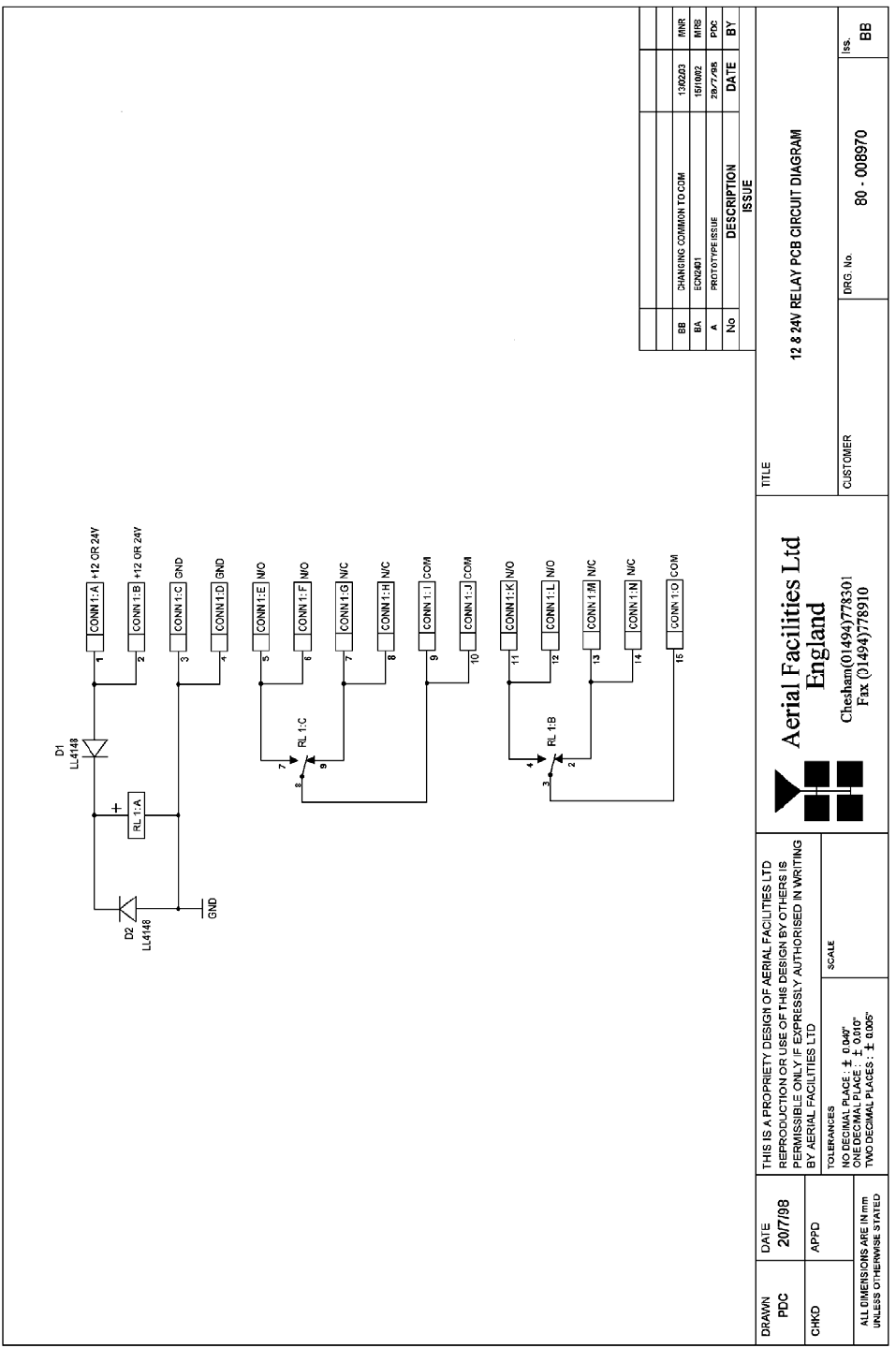
4.10.3 12 or 24V Relay PCB Pin-Outs, Drg. # 80-008970
Two Channel UHF Cell Enhancer
User Handbook
Handbook Number: 50-187601HBKM Page: 41 of 51
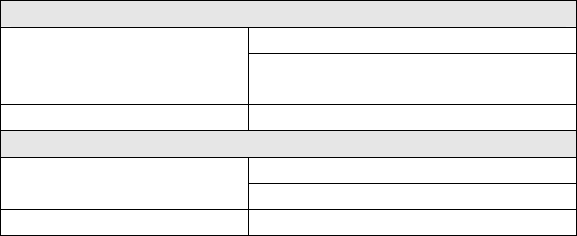
Two Channel UHF Cell Enhancer
User Handbook
Handbook Number: 50-187601HBKM Page: 42 of 51
4.11 12V Switch-Mode PSU (96-300052)
4.11.1 Description
The power supply unit is a switched-mode type capable of supplying 12V DC at 12.5Amps
continuously. This unit will draw approximately 7-8Amps at 12V DC, so the PSU’s will be used
conservatively ensuring a long operational lifetime.
No routine maintenance of the PSU’s is required. If a fault is suspected, then the output voltage from
the power supply may be measured on its output terminals. This is typically set to 12.2V. The
adjustment potentiometer will be found close to the DC output terminals.
All the PSU’s used in AFL Cell Enhancers are capable of operation from either 110 or 220V nominal
AC supplies. The line voltage is sensed automatically, so no adjustment or link setting is needed by
the operator.
4.11.2 Technical Specification
AC Input Supply
110 or 220V nominal
Voltage: 90 to 132 or 180 to 264V
(absolute limits)
Frequency: 47 to 63Hz
DC Output Supply
12V DC (nominal)
Voltage: 10.5-13.8V (absolute limits)
Current: 12.5A
Two Channel UHF Cell Enhancer
User Handbook
Handbook Number: 50-187601HBKM Page: 43 of 51
5. INSTALLATION
5.1 Initial Installation Record
When this equipment is initially commissioned, please use the equipment set-up record sheet in
Appendix A. This will help both the installation personnel and AFL should these figures be needed for
future reference or diagnosis.
6. FAULT FINDING & MAINTENANCE
6.1 General Fault Finding Procedures
In the event that the performance of the system is suspect, a methodical and logical approach to the
problem will reveal the cause of the difficulty.
Transmissions from the main base stations are passed though the system to the mobile radio
equipment; this could be a handheld radio or a transceiver in a vehicle. This path is referred to as the
downlink. The return signal path from the mobile radio equipment to the base station is referred to as
the uplink.
The first operation is to check the alarms of each of the active units and determine that the power
supplies to the equipment are connected and active.
This can be achieved remotely (via CEMS, the RS232 Coverage Enhancement Management System,
if fitted), or locally with the front panel LED’s. The green LED on the front panel should be illuminated,
while the red alarm indicator should be off.
If an Alarm is on, then that individual shelf/module must be isolated and individually tested against the
original test specification.
The individual amplifier units within the shelf have a green LED showing through a hole in their piggy-
back alarm board, which is illuminated if the unit is working correctly.
If an amplifier is suspect, check the DC power supply to the unit. If no other fault is apparent use a
spectrum analyser to measure the incoming signal level at the input and then after reconnecting the
amplifier input, measure the output level. Consult with the system diagram to determine the expected
gain and compare result.
In the event that there are no alarms on and all units appear to be functioning it will be necessary to
test the system in a systematic manner to confirm correct operation.
Two Channel UHF Cell Enhancer
User Handbook
Handbook Number: 50-187601HBKM Page: 44 of 51
6.2 Downlink
Confirm that there is a signal at the expected frequency and strength from the base station. If this is
not present then the fault may lay outside the system. To confirm this, inject a downlink frequency
signal from a known source at the master site BTS input and check for output at the remote site
feeder output.
If a signal is not received at the output it will be necessary to follow the downlink path through the
system to find a point at which the signal is lost. The expected downlink output for the given input can
be found in the end-to-end test specification.
6.3 Uplink
Testing the uplink involves a similar procedure to the downlink except that the frequencies used are
those transmitted by the mobile equipment.
6.4 Fault repair
Once a faulty component has been identified, a decision must be made on the appropriate course to
carry out a repair. A competent engineer can quickly remedy typical faults such as faulty connections
or cables. The exceptions to this are cable assemblies connecting bandpass filter assemblies that are
manufactured to critical lengths to maintain a 50-ohm system. Care should be taken when replacing
cables or connectors to ensure that items are of the correct specification. The repair of component
modules such as amplifiers and bandpass filters will not usually be possible in the field, as they
frequently require specialist knowledge and test equipment to ensure correct operation. It is
recommended that items of this type are replaced with a spare unit and the faulty unit returned to AFL
for repair.
Two Channel UHF Cell Enhancer
User Handbook
Handbook Number: 50-187601HBKM Page: 45 of 51
6.5 Checking service
Following the repair of any part of the system it is recommended that a full end-to-end test is carried
out in accordance with the test specification and that the coverage is checked by survey.
It is important to bear in mind that the system includes a radiating cable network and base stations
that may be faulty or may have been damaged.
6.6 Service Support
Advice and assistance with maintaining and servicing this system are available by contacting Aerial
Facilities Ltd.
6.7 Tools & Test Equipment
The minimum tools and test equipment needed to successfully service this AFL product are as
follows:-
Spectrum analyser: 100kHz to 2GHz (Dynamic range = 90dB).
Signal Generator: 30MHz to 2GHz (-120dBm to 0dBm o/p level).
Attenuator: 20dB, 10W, DC-2GHz, (N male – N female).
Test Antenna: Yagi or dipole for operating frequency.
Digital multi-meter: Universal Volt-Ohm-Amp meter.
Test cable x 2: N male – N male, 2M long RG214.
Test cable x 2: SMA male – N male, 1m long RG223.
Hand tools: Philips #1&2 tip screwdriver.
3mm flat bladed screwdriver.
SMA spanner and torque setter.
Two Channel UHF Cell Enhancer
User Handbook
Handbook Number: 50-187601HBKM Page: 46 of 51
6.8 General Maintenance Procedures
Many of the active modules contain semiconductor devices utilising MOS technology, which can be
damaged by electrostatic discharge. Correct handling of such modules is mandatory to ensure their
long-term reliability.
To prevent damage to a module, it must be withdrawn/inserted with care. The module may have
connectors on its underside, which might not be visible to the service operative.
6.9 Module Removal (LNA’s, general procedure)
The following general rules should be followed to remove a module:
1 Remove power to the unit
2 Remove all visible connectors (RF, DC & alarm)
3 Release module retaining screws.
4 Slowly but firmly, pull the module straight out of its position. Take care not to twist/turn the
module during withdrawal. (When the module is loose, care may be needed, as there may be
concealed connections underneath).
6.10 Module Replacement (general)
1 Carefully align the module into its location then slowly push the module directly straight into its
position, taking care not to twist/turn it during insertion.
2 Reconnect all connectors, RF, alarm, power etc.,(concealed connectors may have to be
connected first).
3 Replace retaining screws (if any).
4 Double-check all connections before applying power.
6.11 Power Amplifiers
1) Remove power to the unit. (Switch off @ mains/battery, or remove DC in connector)
2) Remove alarm wires from alarm screw terminal block or disconnect multi-way alarm
connector.
3) Carefully disconnect the RF input and output coaxial connectors (usually SMA)
If alarm board removal is not required, go to step 5.
4) There is (usually) a plate attached to the alarm board which fixes it to the amplifier, remove its
retaining screws and the alarm board can be withdrawn from the amplifier in its entirety. On certain
types of amplifier the alarm board is not mounted on a dedicated mounting plate; in this case it will
have to firstly be removed by unscrewing it from the mounting pillars, in most cases, the pillars will not
have not have to be removed before lifting the amplifier.
5) If the amplifier to be removed has a heatsink attached, there may be several different ways it
can have been assembled. The most commonly used method, is screws through the front of the
heatsink to threaded screw holes (or nuts and bolts), into the amplifier within the main case. If the
heatsink is mounted on the rear of the main case (e.g., against a wall in the case of wall mounted
enclosures), then the fixing method for the heatsink will be from within the case, (otherwise the
enclosure would have to be removed from the wall in order to remove the heatsink).
When the heatsink has been removed, the amplifier may be unscrewed from the main casing by its
four corner fixings and gently withdrawn.
Two Channel UHF Cell Enhancer
User Handbook
Handbook Number: 50-187601HBKM Page: 47 of 51
Fitting a new power amplifier module will be the exact reverse of the above.
Note: Do not forget to apply fresh heatsink compound to the heatsink/main case joint and also
between the amplifier and the main case.
6.12 Low Power Amplifier Replacement
Disconnect the mains power supply and disconnect the 24V dc supply connector for the LPA.
Disconnect the RF input and output cables from the LPA.
Disconnect the alarm connector.
Remove the alarm monitoring wires from (D type connector) pins 9 and 10.
Remove the LPA module by removing the four retaining screws, replace with a new LPA module and
secure it with the screws.
Connect the RF cables to the LPA input and output connectors. Reconnect the wires to the alarm
board connector pins 9 and 10.
Reconnect the DC supply connector and turn the mains switch on.
Note: Tighten SMA connectors using only a dedicated SMA torque spanner. If SMA connectors are
over-tightened, irreparable damage will occur. . Do not use adjustable pliers to loosen/tighten SMA
connectors.
Also take care not to drop or knock the module as this can damage (or misalign in the case of tuned
passive modules) sensitive internal components. Always store the modules in an environmentally
friendly location
6.13 Module Transportation
To maintain the operation, performance and reliability of any module it must be stored and
transported correctly. Any module not installed in a whole system must be kept in an anti-static bag or
container. These bags or containers are normally identified by being pink or black, and are often
marked with an ESD label. Any module sent back to AFL for investigation/repair must be so
protected. Please contact AFL’s quality department before returning a module.
Two Channel UHF Cell Enhancer
User Handbook
Handbook Number: 50-187601HBKM Page: 48 of 51
APPENDIX A
Amendment List Record Sheet
Issue No. Date Incorporated
by
Page Nos.
Amended
Reason for
new issue
A 22/05/2007 CMH 1st Draft
Document Ref:-50-187601HBKM
Two Channel UHF Cell Enhancer
User Handbook
Handbook Number: 50-187601HBKM Page: 49 of 51
Glossary of Terms
Repeater or
Cell Enhancer
A Radio Frequency (RF) amplifier which can simultaneously
amplify and re-broadcast Mobile Station (MS) and Base
Transceiver Station (BTS) signals.
Band Selective
Repeater
A Cell Enhancer designed for operation on a range of channels
within a specified frequency band.
Channel Selective
Repeater
A Cell Enhancer, designed for operation on specified channel(s)
within a specified frequency band. Channel frequencies may be
factory set or on-site programmable.
AC Alternating Current
AGC Automatic Gain Control
BBU Battery Backup Unit
BTS Base Transceiver Station
CEMS Coverage Enhanced Management System
C/NR Carrier-to-Noise Ratio
DC Direct Current
Downlink (D/L) RF signals Tx from the BTS to the Master Site
FO Fibre Optic
GND Ground
ID Identification Number
LED Light Emitting Diode
LNA Low Noise Amplifier
LPA Low Power Amplifier
MOU Master Optical Unit
M.S. Mobile Station
MTBF Mean Time Between Failures
N/A Not Applicable
N/C No Connection
OFR On Frequency Repeater
OIP3 Output Third Order Intercept Point = RFout +(C/I)/2
PA Power Amplifier
RF Radio Frequency
RSA Receiver/Splitter Amplifier
Rx Receiver
S/N Serial Number
Tx Transmitter
Uplink (U/L) RF signals transmitted from the MS to the BTS
VSWR Voltage Standing Wave Ratio
WDM Wave division multiplex
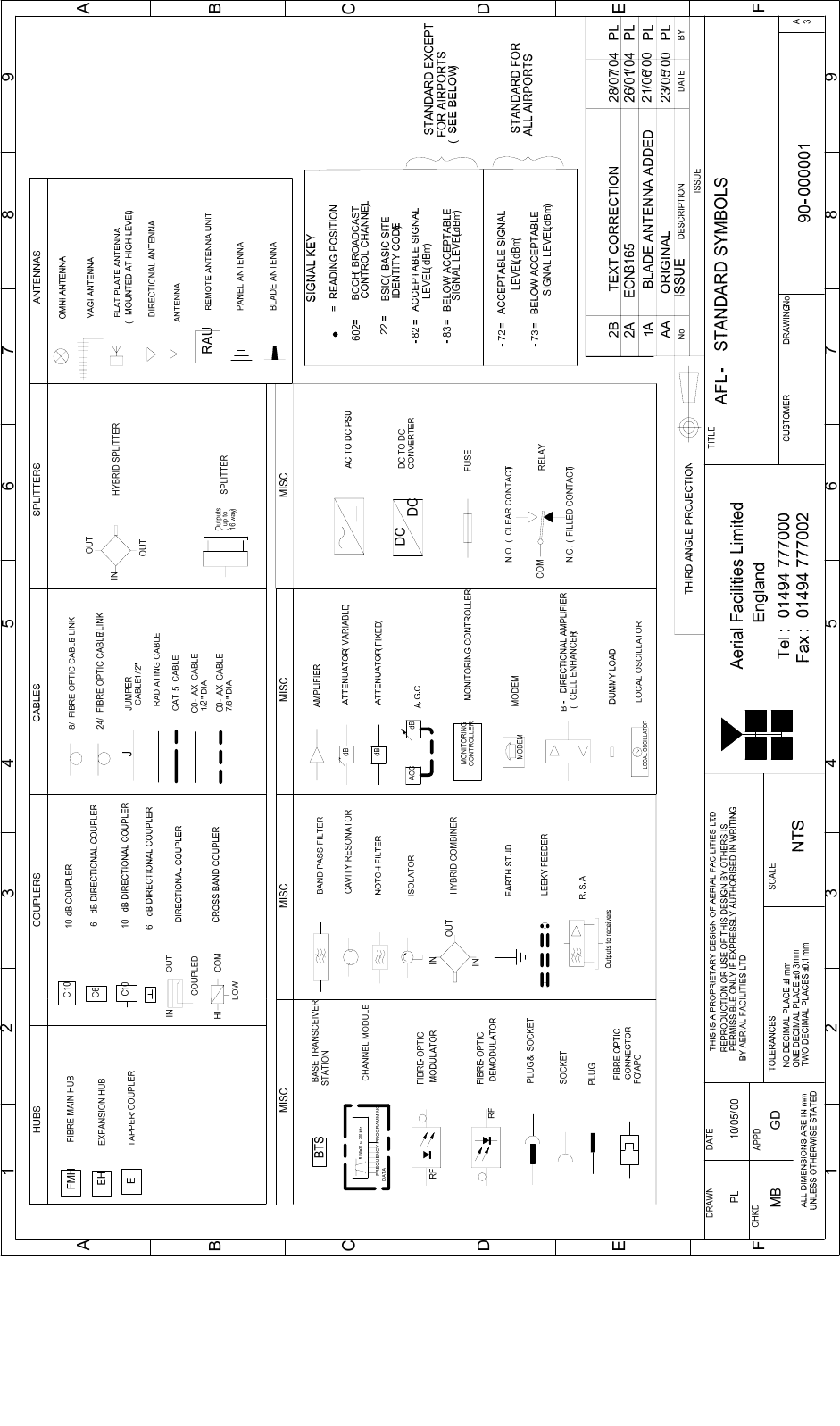
Key to AFL Drawing Symbols, Drg. # 90-000001
Two Channel UHF Cell Enhancer
User Handbook
Handbook Number: 50-187601HBKM Page: 50 of 51
Two Channel UHF Cell Enhancer
User Handbook
Handbook Number: 50-187601HBKM Page: 51 of 51
APPENDIX B
Initial Equipment Set-Up Calculations
General Information
Site Name: Client Name:
Date: AFL Equip. Model No.
Antenna Systems
Model Gain Azimuth Comments
A - Service Antenna
B – Donor Antenna
Type Loss Length Comments
C – Service Feeder
D – Donor Feeder
Initial Parameters
E – CE Output Power dBm
F – Antenna Isolation dB
G – Input signal level from donor BTS dBm
Operating Voltage V
Downlink Calculations
Parameter Comments Value
Input signal level (G) dBm
CE max. o/p power (E) dBm
Gain setting E - G dB
Isolation required (Gain + 10dB) dB
Service antenna gain (A) dB
Service antenna feeder loss (C) dB
Effective radiated power (ERP) E+A-C dBm
Attenuator setting CE gain-gain setting dB
If the input signal level in the uplink path is known and steady, use the following calculation table to
determine the gain setting. If the CE features Automatic Gain Control the attenuator should be set to
zero and if not, then the attenuation setting for both uplink and downlink should be similar.
Uplink Calculations
Parameter Comments Value
Input signal level dBm
CE max. o/p power (E) dBm
Gain setting dB
Required isolation dB
Donor antenna gain (B) dB
Donor antenna feeder loss (D) dB
Effective radiated power (ERP) E+B-D dBm
Attenuator setting (CE gain-gain setting) dB